Creating a Smooth Work-From-Home Environment
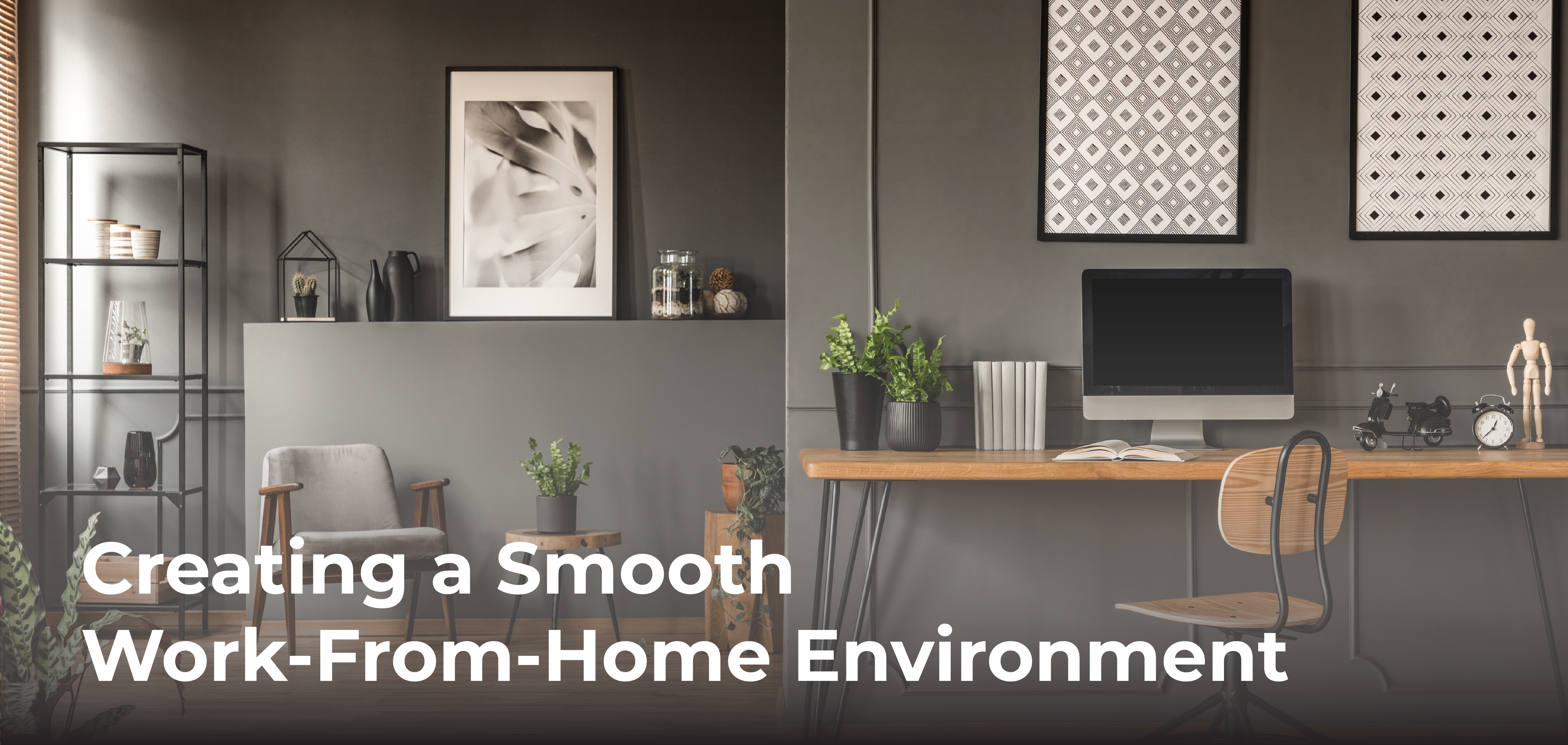
Your home should be a comfortable haven where you can rest and recover, but when you work at home, it also needs to be a place where your focus is high. Is it possible to reach both of these goals? The good news is that it is possible to balance relaxation and efficiency. Deliberately creating a work from home office setup that is exclusively for getting work done, can even increase your productivity.
Physical Separation and Boundaries
The first step is creating a distinct separation between your workspace and the rest of the home. The layout and décor in your office should be focused on your work goals. According to productivity experts, just stepping into your office should put you into a constructive frame of mind. Even if you don’t have an entire room to dedicate to work, use the same philosophy when sectioning off an area of a room.
Purpose-Led Focus
The second step is designing each environment with its purpose in mind. For example, choose stimulating décor for your office space and relaxing paint colors and embellishments for the rest of the home:
- Choose office furnishings based on functionality, such as storage and organization, as well as using accessories that prompt creativity.
- Consider the ergonomics of your office supplies and furniture.
- Pick lighting that is bright with cool colors for your office space and warmer lighting for the bedroom and other rooms where you relax.
- Cut down on clutter throughout the home. This will make your home feel less chaotic.
Design each room with goals in mind. Gather the tools for washing clothes in the laundry room. Store family activities in the family room. Choosing the right furnishings for each room encourages the appropriate mindset for the work done in that area. You can also designate a specific space for personal wellness, such as an exercise room or a place for meditation.

Rules and Habits for Productivity
The third step is establishing rules and habits for your workspace. When working at home, it is easy to become distracted by household chores, children, pets, and other home-based attractions. Avoid disrupting your productive flow state by clearly communicating that you must not be disturbed:
- Work in an area of the home that is least likely to be noisy.
- Close a door between your workspace and the rest of the home.
- Hang up a sign that you are working.
- Wear headphones that cancel out background noise.
- Keep a calendar and timer handy. It’s easier to stay on task when you have a concrete start and stop time.
- Don’t store distractions in your office. Some gadgets pull your attention away from work.
It’s equally important to maintain rules about the rest of your home, such as not answering work texts and emails when you’re not in the office. Be as clear about boundaries with your co-workers as you are with your family.
Limited Overlap
Your fourth step is preventing overflow from one space to the other. This does not imply you can’t have a cohesive decorating plan. Artwork, plants, flowers, and furnishings can follow an overall theme. Instead, this means that you don’t carry your work from the office into the rest of your home, and you don’t take laundry into the office. Even if your workspace is a corner of the kitchen, keep dishes and meal prep away from your designated office space.
Working from home offers many benefits, and it is possible to have a productive workspace while creating a relaxing environment in the rest of your home. With physical divisions, rules about disruptions, and clear boundaries separating work and home, you can enjoy productivity and peace by moving from one part of the home to another.
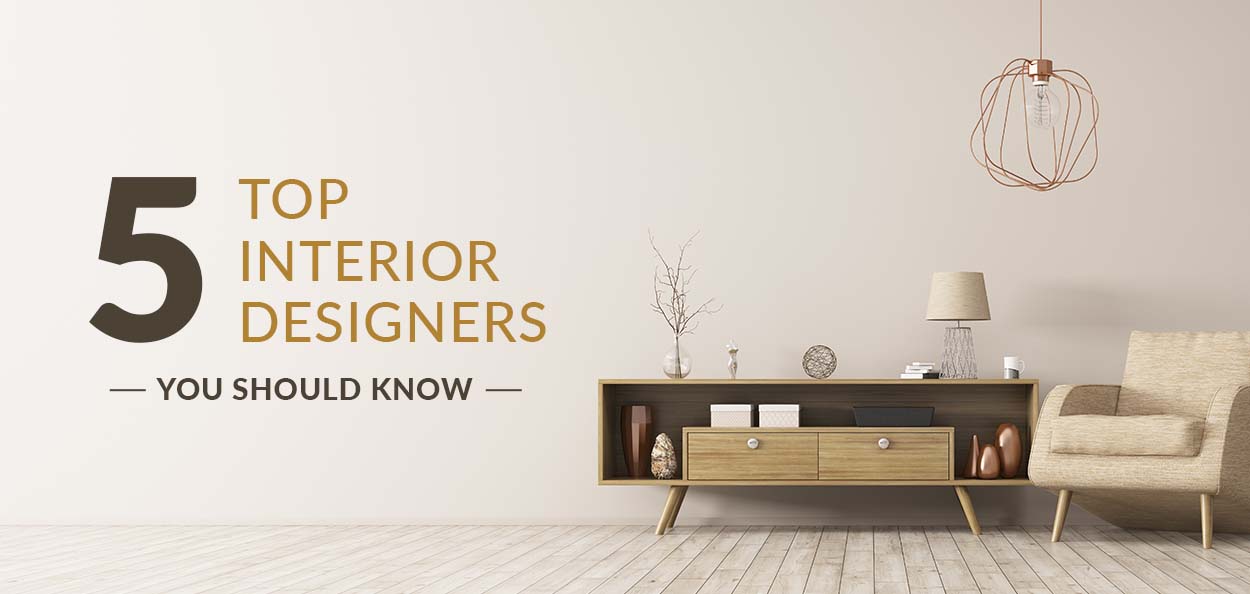
We love filling your screen with beautiful homes and interior design tips and trends, but have you ever wondered who or what inspires these looks? From designers who carefully curate celebrity homes to some of our favorite home design television personalities, there is an abundance of talent in the interior design world. Below, we’re going to fill you in on some of the top interior designers that you should be following so you can stay on top of design trends and inspiration!
List of Interior Designers to Follow
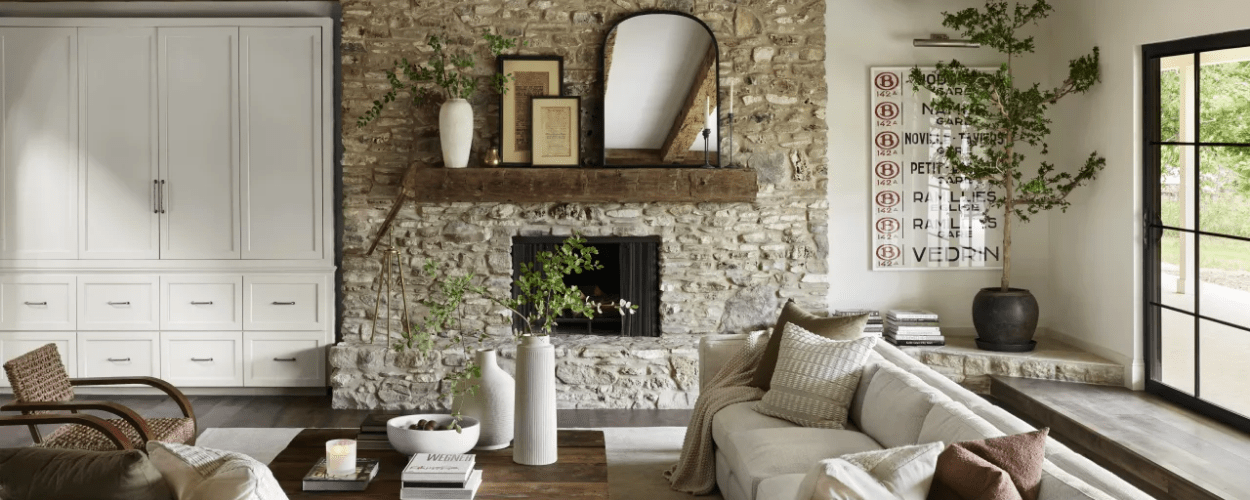 Image from the Magnolia Network
Image from the Magnolia Network
Joanna Gaines
Could we possibly create a list of top interior designers without adding the farmhouse queen herself, Joanna Gaines? It’s been less than a decade since Joanna and her hammer toting husband took over our televisions with Fixer Upper. Her name has become synonymous with shiplap and Waco, Texas. Her style can be described with many words – classic, simple, fresh, cozy, rustic. Metallic hardware and light fixtures add industrial touches to the farmhouse motif she embodies in her designs. Farmhouse interior design may or may not be your thing, but there is no doubt that when someone makes a list of interior designers, Joanna Gaines is at the top.
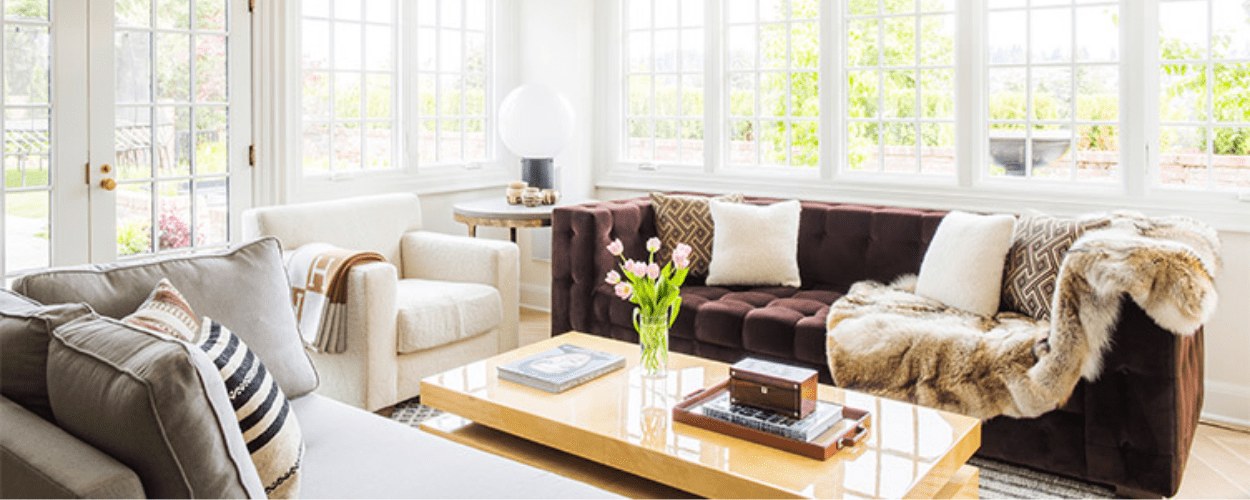 Image from Nate Berkus
Image from Nate Berkus
Nate Berkus
Nate Berkus started his award-winning design firm at 24 years old with the motto, “I believe your home should tell your story. What you love most is collected and assembled in one place.” After regularly appearing on The Oprah Winfrey Show, this top interior designer became a bestselling author and has starred in several television shows of his own. He has perfected his art of interior design by featuring neutrals and warm tones in an elegant, modern-traditional styling, but he isn’t afraid to add pops of color. This photo from one of Nate’s Seattle home designs seamlessly shows how to arrange two sofas in one room.
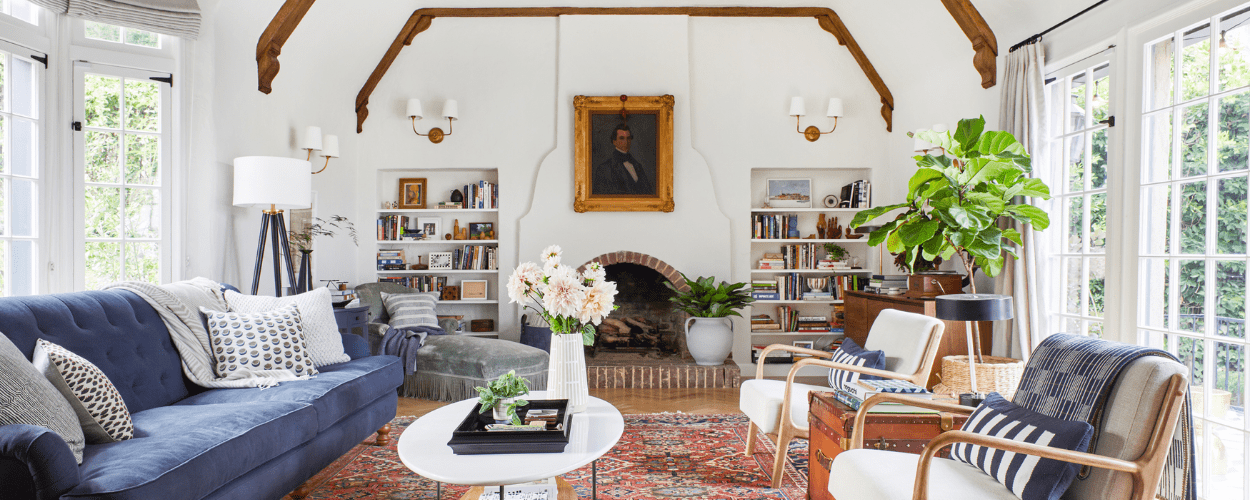 Image from Style By Emily Henderson
Image from Style By Emily Henderson
Emily Henderson
You can find our next top interior designer on HGTV, host of Secrets from a Stylist, Emily Henderson. Along with her television gig and top interior designer rank, she’s also a popular blogger and her Instagram has over 962,000 followers. Her blog is full of advice about the art of interior design, how to style, budget ideas, design trends, and even home makeovers, making her the perfect interior designer to draw inspiration from! We love her cheerful style and use of color; that’s what makes her one of our favorite top interior designers.
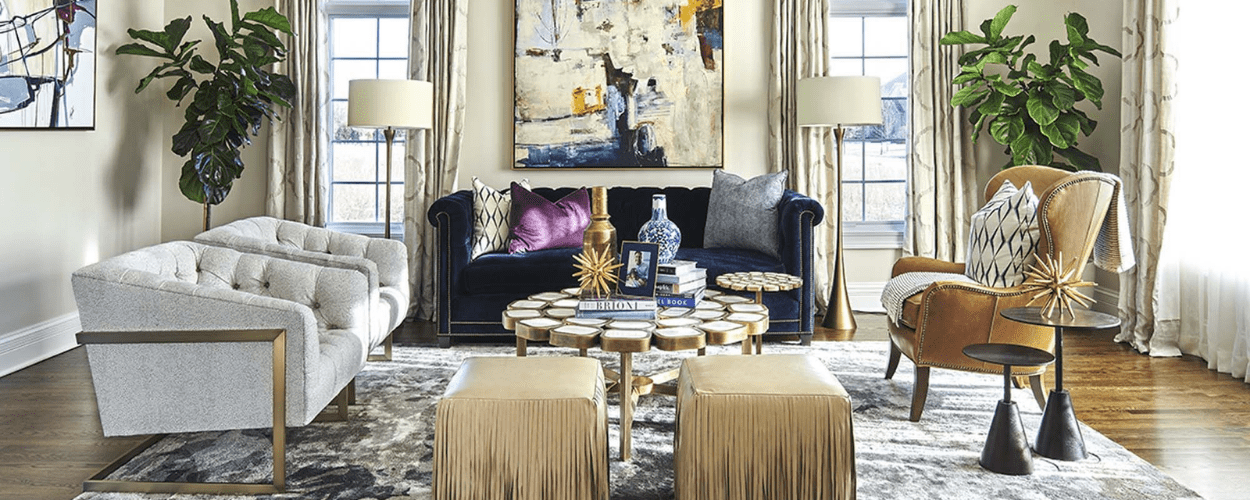 Image from Tiffany Brooks Interiors
Image from Tiffany Brooks Interiors
Tiffany Brooks
Tiffany Brooks is recognizable as one of the stars of HGTV. She started her design firm, Tiffany Brooks Interiors, in 2007 and has designed homes from Atlanta to Los Angeles. Tiffany describes her designs as “classic with a twist”. Not one to shy from color or patterns, we love her funky style and her unique taste. She has been named one of the top 20 famous interior designers working today by Architectural Digest, the most sought-after interior designer in Chicago, and listed as one of the top 20 African American interior designers in the nation, so she’s obviously got to make this list of interior designers to follow!
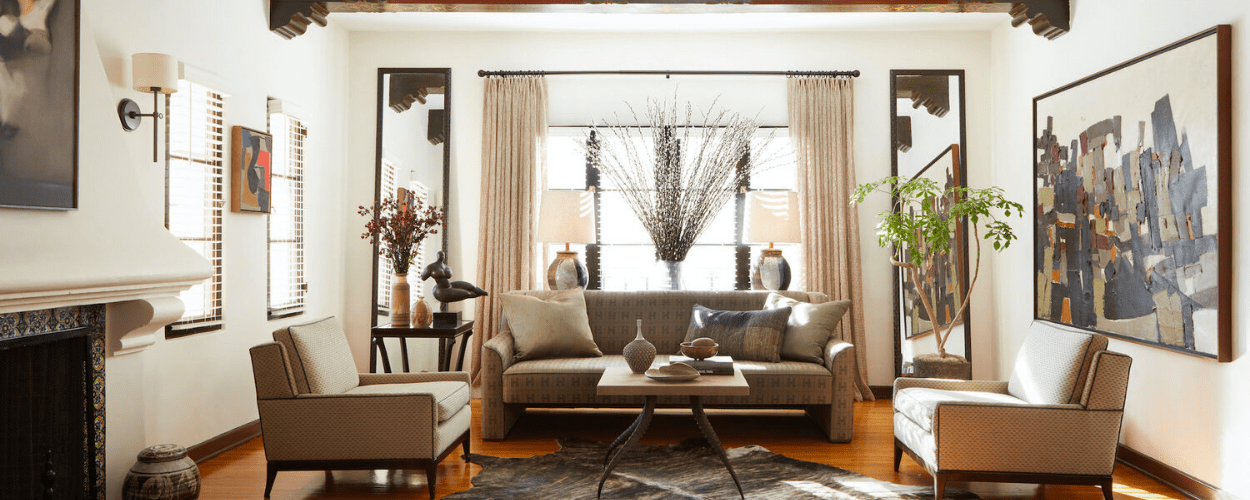 Image from Jeff Andrews
Image from Jeff Andrews
Jeff Andrews
When we think about top interior designers, we ask ourselves “who do the celebrities use?” Well, when it comes to designing for the stars, the client list of Jeff Andrews is one of the most enviable in the industry. Stars like Kris and Kendall Jenner, Kourtney Kardashian, Ryan Seacrest, and America Ferrera love Jeff’s designs and use them for their homes. His bold designs are warm and sophisticated. We love the use of different textures and natural light to bring luxury to his interior designs.
Whether you’re looking to update your home with a new style or just like following along with new trends, be sure to follow this list of interior designers for tips, tricks, and inspiration.
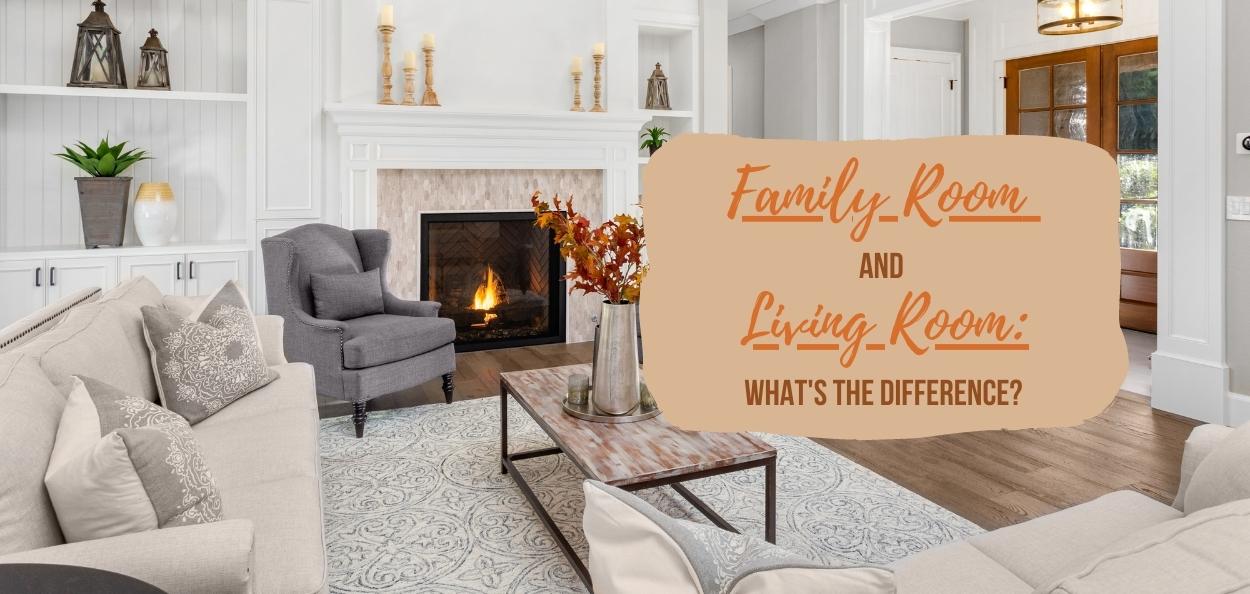
You have probably heard the terms “family room” and “living room” used interchangeably, but do they really mean the same thing? Though both rooms do have similar functions – to serve as a living space for gatherings and shared moments – there are distinct differences between living rooms and family rooms that set each space apart. Read on to learn about the key characteristics of each room, their purpose, and how that affects the decor in these spaces.
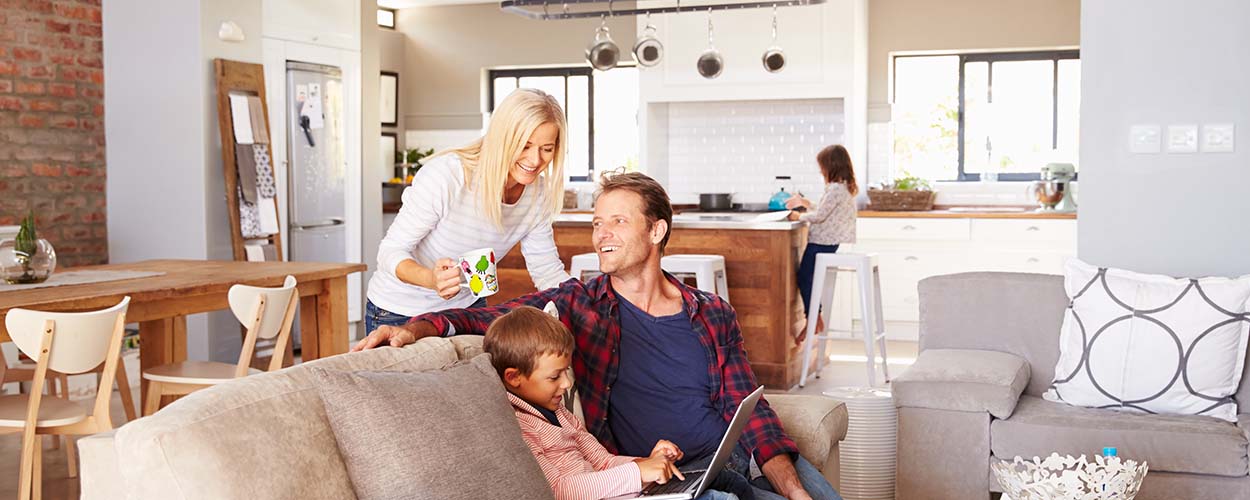
What is a Family Room?
For homes with more than one living room, family rooms are typically thought of as a less formal gathering space. As the name hints, the family room is where you spend most of your time with family. Whether it’s watching TV, playing board games, or just hanging out, the family room is a casual space to do everyday activities.
Family rooms tend to be located further back in the home, leading into the kitchen or oftentimes into an outdoor deck or patio. Because this space is regularly used for family game nights and other kid-friendly activities, its layout leaves a wide open space for kids to play and people to move around.
Family Room Furniture
Overall, family room furniture is centered around comfortability and practicality. While luxurious pieces with contemporary designs may look stunning, they probably aren’t the best investment for your family room.
Because this space is all about functionality, it’s smart to choose family room furniture without sharp edges or elements that can easily be damaged. Prioritize performance and stain-resistance for furniture in this room.
Along with durable, comfy furniture, think about showcasing personal photos and other memorabilia that complements the theme of this room—family. Gaming consoles, TVs, and other entertainment-based decor are perfect for this space as well.
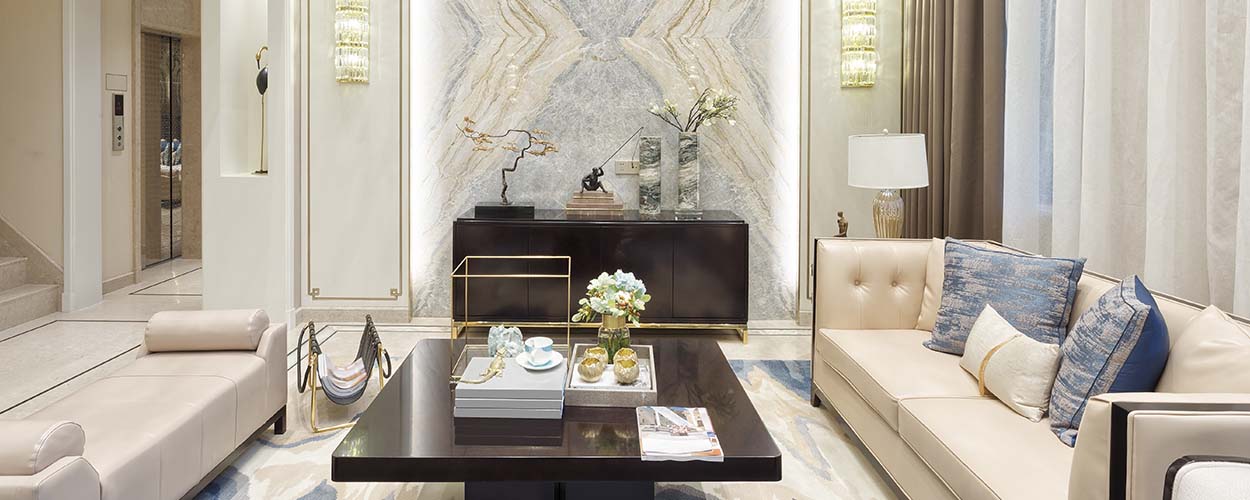
What is a Living Room?
The biggest difference between living rooms and family rooms is functionality. Unlike the family room, the living room is centered around formality. It’s a great place to host more formal gatherings that include intimate conversation over cocktails or coffee.
In addition to functionality, living rooms also tend to have a different location within the home. The living room is typically one of the first rooms you see when you enter a house.
Living Room Furniture
Because family rooms and living rooms serve two distinct purposes within your home, the furniture in each space can vary quite a bit. Given the more formal ambiance of a living room, it’s appropriate to include expensive, luxurious furniture and decoration pieces. Precious family heirlooms, antiques, art collections, and other delicate decor pieces make for beautiful accessories in this space.
Typically, the living room is the largest room in the house. With much more space to work with, feel free to choose larger furniture pieces that fill up the empty floor space. You can also show off your interior decorating skills by including more accessories as well.
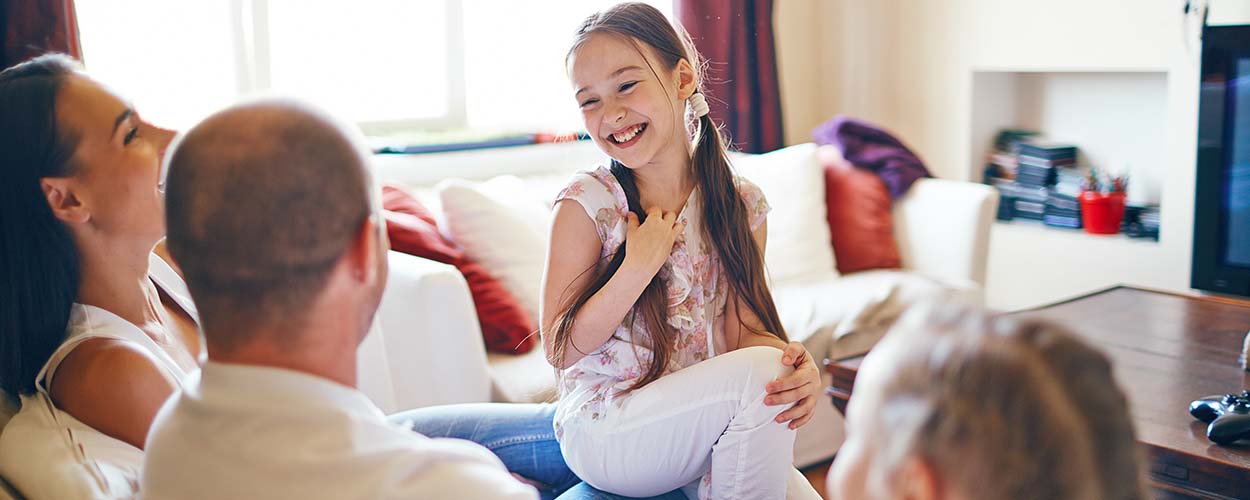
Are Both Family Rooms and Living Rooms Essential?
To answer this question, it’s important to consider your home’s floor plan and your family’s lifestyle. There is no perfect blue print for every home, so focus on what is most practical for your family and go for it! No matter if you have just a family room, or living room, or both, focus on creating space for you and your loved ones to come together and enjoy each other’s company!
Now that you have a better understanding of family rooms and living rooms, you should feel much more prepared to tackle your interior decorating. After you finish furnishing your space, check out these 6 seating arrangements to try in your living room.
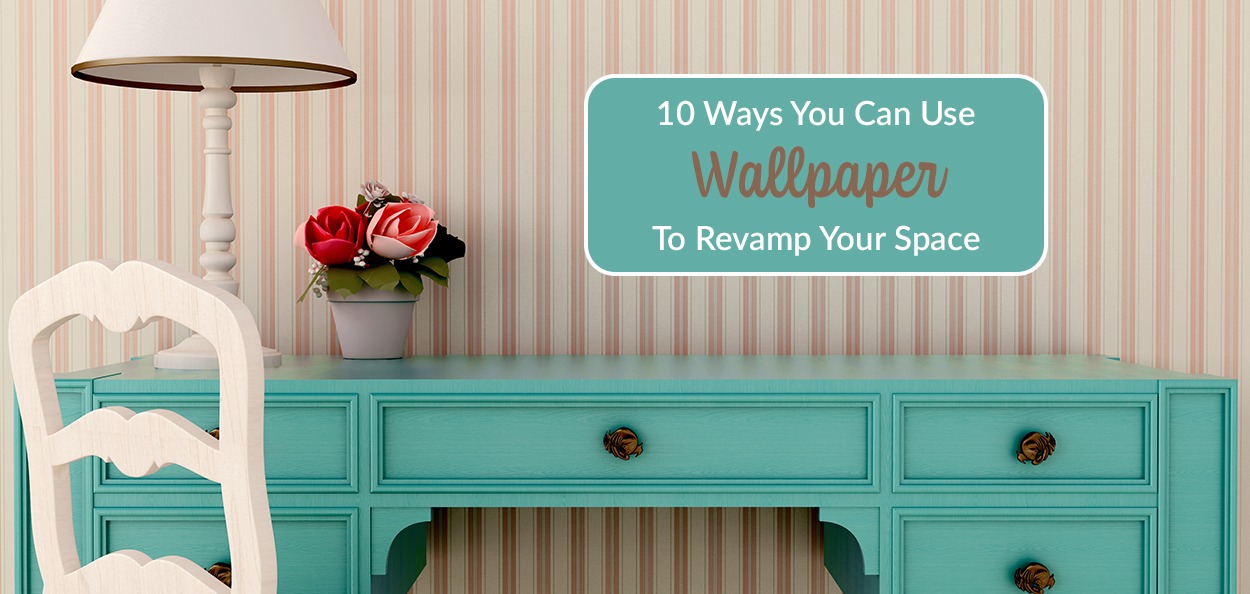
Do you feel like your living space needs some personality? Don’t be afraid to venture out from minimalist, bare walls to colorful focal points made with wallpaper.
Wallpaper has been around for ages and is currently a major trend in the interior design world. From floral prints to geometric masterpieces, check out 10 unique ways to use wallpaper throughout your space.
1. Mixture of Wallpaper
Having a hard time choosing between different wallpaper options? Try your hand at incorporating a mixture of designs. Mixing and matching wallpaper may seem like a risky route to take, but it can actually look quite cohesive if you stay within the same color palette and patterns. Here are a couple guidelines to follow:
- Stick to two different color options to avoid a messy design
- Use each wallpaper on different walls of your room or at least in different places like your accent furniture
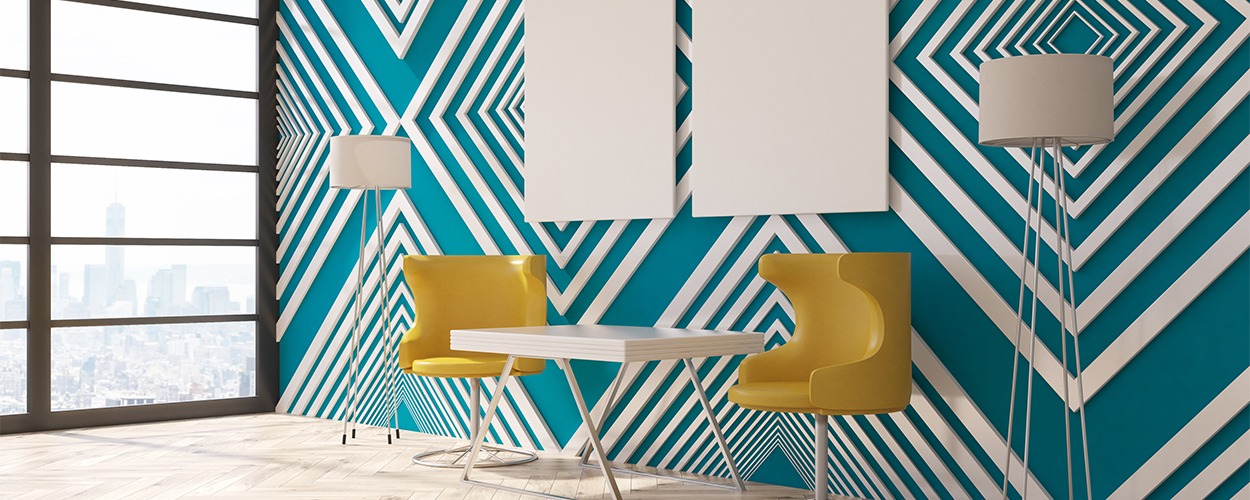
2. Statement Wall
Consider featuring a striking and colorful wallpaper within a single space to create a statement wall. A statement wall will most definitely catch the eye of your guests and can quickly transform your interior from bland to bold.
While it can look amazing to incorporate a vibrant jungle print or floral design, remember to keep in mind your interior design style as you try this wallpaper idea for your home. Stick with your theme and remember that even the slightest change in color or pattern can go a long way.
3. Wallpaper on the Ceiling
Give your guests a reason to look up and enjoy every corner of your room by adding wallpaper to the ceiling! By using this technique, you can create a really dramatic look in a small space.
This is one of the most unique ways to use wallpaper, so it’s no surprise that the process can be a little tricky. Do your research on papering ceilings to ensure the project goes smoothly and you don’t have to re-do anything. Once you see the outcome, you’ll realize it was well worth the extra effort!
4. Decoupage Furniture
Do you have furniture that has seen better days? Rather than toss it in the trash or go through the hassle of painting, use peel-and-stick wallpaper instead. Simply place your wallpaper on the surface of your furniture to create stand-out items that make for fantastic room accents.
An easy DIY project to try is adding wallpaper on the faces of dresser drawers or your nightstands. You can even add wallpaper to the top of your desk as well.
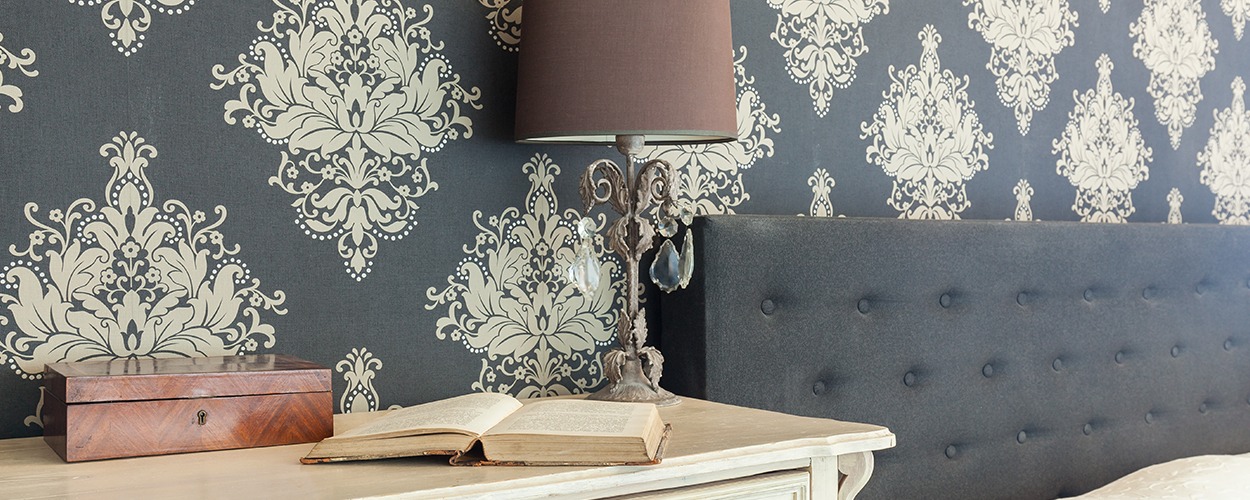
5. Colorful Headboard
The bed is typically the most significant piece of furniture in any bedroom, so why not give it the “wow factor” that packs a visual punch? Add wallpaper to your headboard to give your space a more modern feel.
If you don’t have a headboard, don’t worry! You can still mimic this wallpaper inspiration for the bedroom by creating the illusion of a headboard. Grab some peel-and-stick wallpaper and cut out the shape of a headboard. Stick your template on the wall behind the bed and enjoy the finished product.
6. Back of the Closet
Show off your personality and have a little fun with your home by updating your coat closet! Apply wallpaper to the back of the closet for a subtle, yet vibrant design addition. This wallpaper idea for your home will surely catch the attention of your guests as they hang up their coats.
If you’re looking for wallpaper inspiration for your bedroom, this idea works well too! Complement your wardrobe by adding wallpaper to your own bedroom closet.
7. Back of Shelves
Add depth and charm to your living space by incorporating wallpaper into your bookcase or shelving. This idea is handy if you rent a smaller home with little room to add personal touches.
Take your favorite peel-and-stick wallpaper and add it to the back of your shelves. Not only does this wallpaper idea for your home bring bookcases to life, it also helps give them a high-end look.
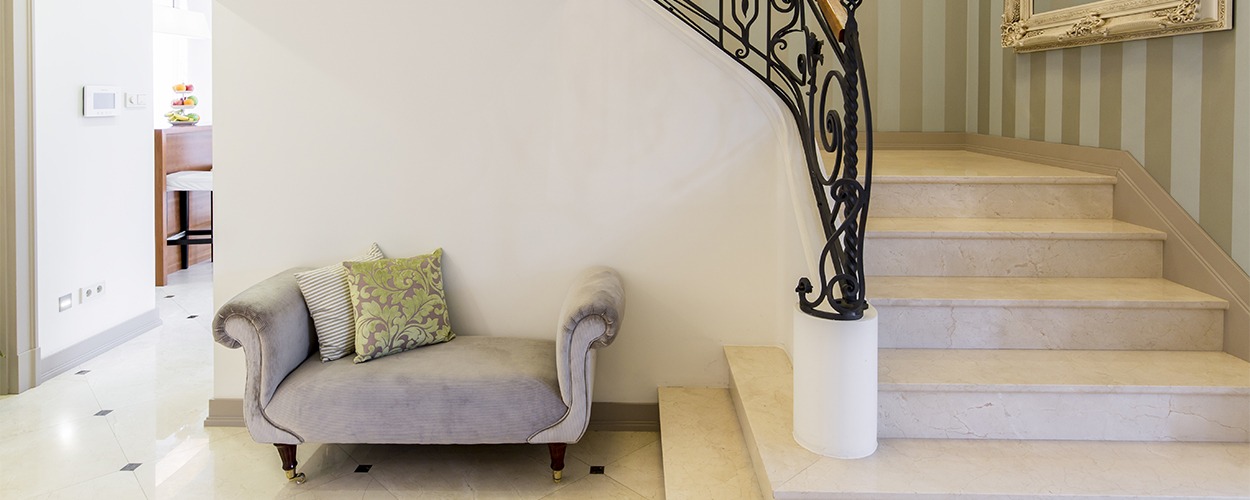
8. The Stairs
Step up your interior decorating by giving your staircase a makeover. Apply wallpaper to your stair risers to add texture and depth. Along with wallpaper on the stairs themselves, you can also try applying wallpaper to your staircase wall. This will transform your staircase into a beautiful focal point in your entryway.
9. Doors
If you’re looking for unique ways to use wallpaper, this one is definitely it! Transform your home’s doors with the addition of wallpaper. Believe it or not, there are hundreds of wallpaper designs especially made for doors. From three-dimensional nature scenes and murals to realistic wood patterns, there are lots of options to fit your preferences.
10. Accent Artwork
Buying designer artwork can be very expensive, so why not get your creative juices flowing and make your own? All you need for this DIY project is a few frames, wallpaper, and a couple hours of free time!
This wallpaper idea for your home is budget-friendly and a perfect way to make art pieces that compliment any room. Along with DIY frames, you can make DIY canvas art by simply sticking wallpaper onto a wooden sheet.
Now that you have some ideas on how to incorporate wallpaper within your home, check out our 10 coolest ideas for a DIY living room makeover!
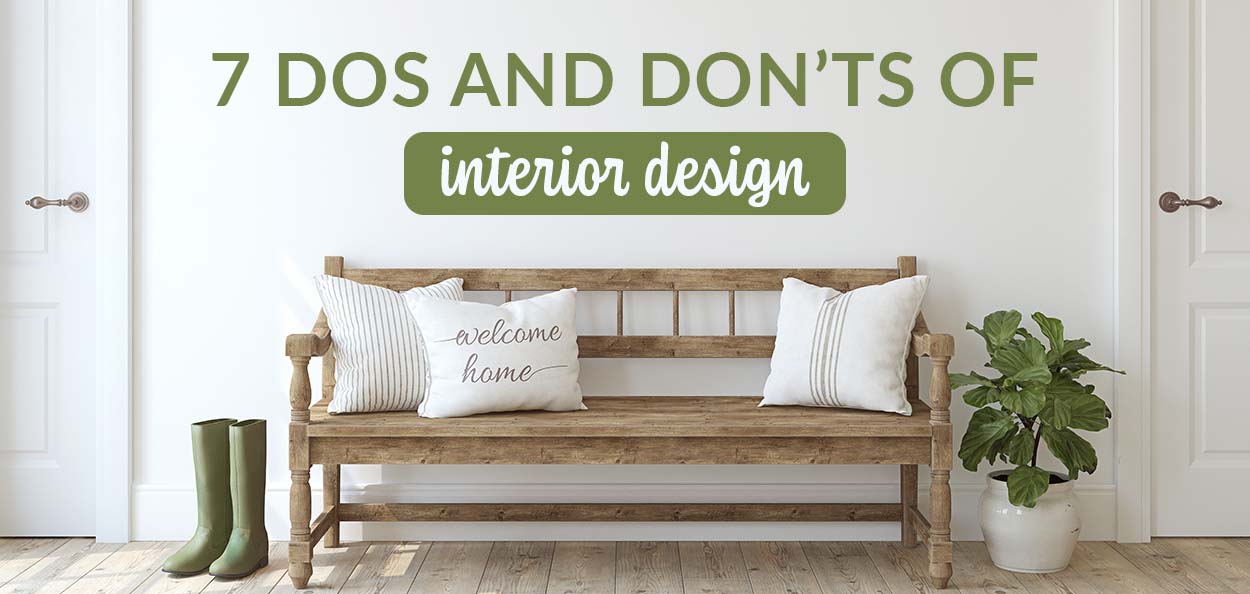
From complementary color palettes to proper furniture arrangements, there is much to think about when it comes to making your house a home. While creating a space that you love should be your number one priority, there are rules of decorating that can guide you in the right direction. Check out these dos and don’ts of interior design!
1. Measuring Furniture
Don’t
Do not buy furniture without measuring it first. The excitement of finding a furniture piece you love can sometimes distract you from critical first steps like measuring your space and the furniture itself. This is one of the biggest interior design mistakes you can make, especially if your item is non-returnable.
Do
Before you even begin your furniture search, record measurements of your space to reference later on. These measurements should include the spot where your furniture will sit, as well as clearances like entryways, hallways, and door frames.
Once you find your favorite furnishings and you’re ready to purchase, grab the furniture dimensions and compare with your home’s measurements to ensure a perfect fit.
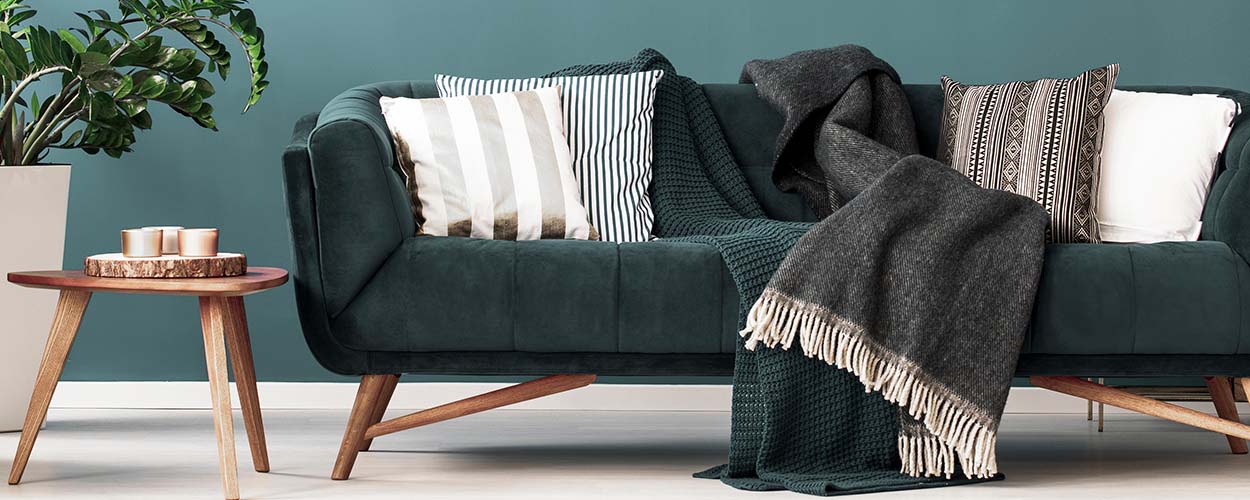
2. Furniture Arrangement
Don’t
Fight every urge to push your furniture against the wall. This is an extremely common interior design mistake because it’s believed to help your room look larger. In reality, it can actually visually shrink your space.
Do
Pull your furniture about two to three inches away from the wall to create a shadow. This will give the illusion of depth and make your space feel more roomy.
3. Area Rugs
Don’t
Don’t purchase rugs that aren’t big enough for your space. Not sure what this means? If the main furnishings in the room cannot fit on top of the rug, it’s too small.
Do
Ideally, you should choose an area rug that will be able to fit all four legs of your room’s furniture pieces. For example, if you have one sofa and two accent chairs, all three pieces should comfortably sit on the rug.
If this isn’t possible, try to fit at least the front legs on the rug. The back legs can hang off.
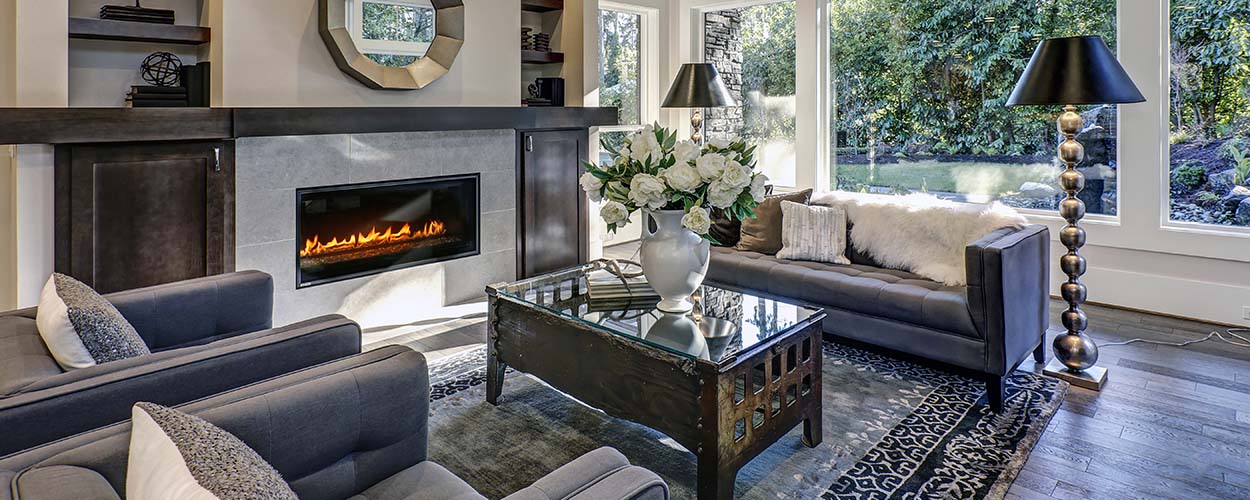
4. Interior Lighting
Don’t
Don’t use just one or two types of lighting throughout your living space. This will create an uneven distribution of light and make your home look darker than it needs to be.
Do
Many people are completely unaware of this rule of decorating, but it’s important that you vary your lighting between ambient, task, and accent lighting. Each type of lighting serves a specific purpose, which is why they’re all important.
From floor lamps and pendant lights to wall sconces and track lights, there are plenty of different light sources that will provide excellent illumination in your home.
5. Wall Art
Don’t
This rule of decorating can vary depending on the situation, but in most cases, design experts encourage you to not hang wall art too high. If placed too far up, wall decor can make a room feel entirely off. Along with that, awkwardly placed wall art can be uncomfortable to look at, especially when you have to crane your neck.
Do
An interior design rule of thumb for wall art is to hang it at or near eye level. It’s visually more pleasing and easier to enjoy, which is exactly what wall art is meant for.
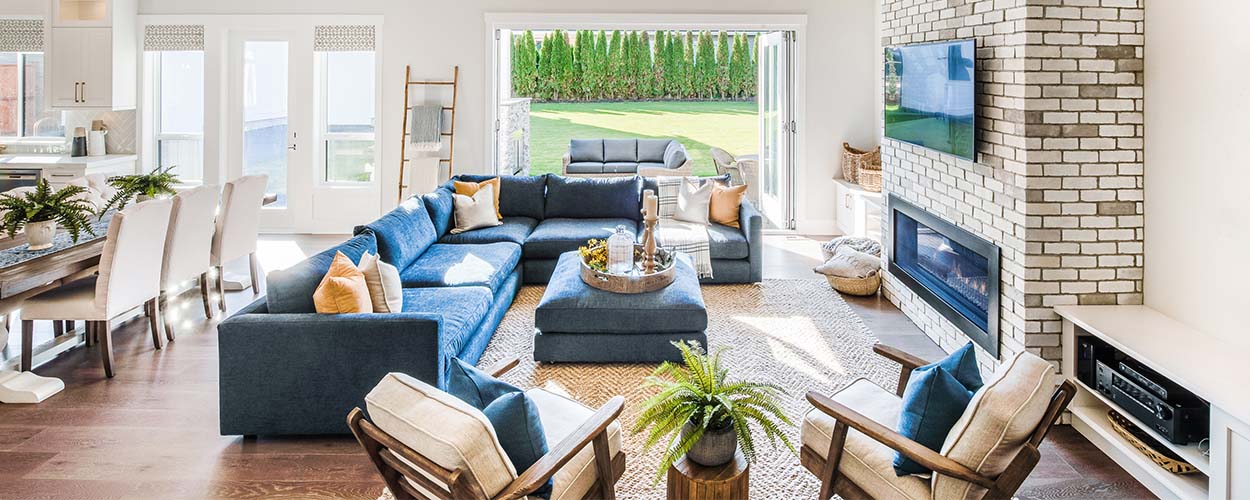
6. Color Schemes
Don’t
A home’s color palette is crucial because it sets the tone and atmosphere for the space. Try your best to avoid extreme or singular color schemes. A home with no color contrast can appear dull and one with too many opposing colors can look disjointed.
Do
As you settle on your favorite color palette, choose a few neutral base colors and bring them to life with a couple accent colors. This well-balanced palette will give your home just the right amount of contrast and create an inviting space.
7. Decor Budget
Don’t
No matter how tight of a budget you have, don’t be afraid to splurge on the most important furnishings. The living room, for example, is one of the most used rooms in the home.
In the short term, it may save you money to buy a cheap, clearance sofa. In the long run, you’ll just end up spending more money replacing it every six months.
Do
Bite the bullet and pay extra for those quality home decor items you know you’ll use often. Comfortable, plush sofas and one-of-a-kind accent chairs are just a couple examples of furniture that are worth the added expense.
Now that you know a few basic rules of decorating, create an even more beautiful home by reading about how to make your rooms flow!
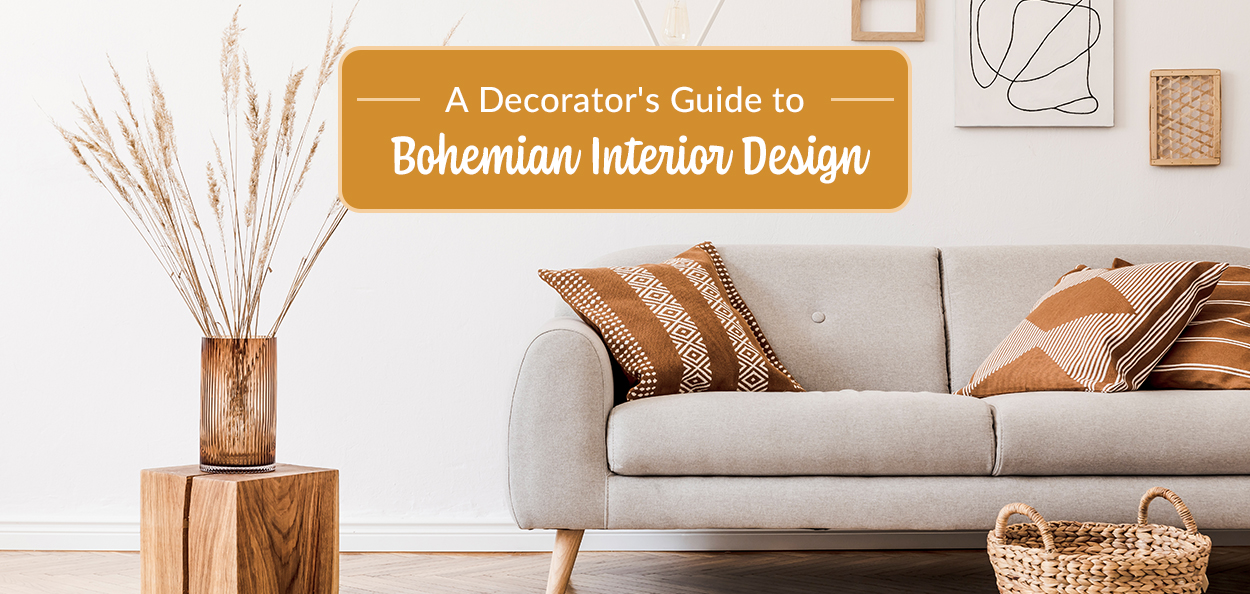
Calling all free-spirited decor lovers! Bohemian design style is colorful, cultural, and quite possibly a swoon worthy match for your design tastes. Explore the artful elements that make up boho design and learn more about how you can infuse it within your home.
What is Bohemian Design Style?
To get a better understanding of this particular interior design style, it’s helpful to know the meaning behind the name. The word “bohemian” is used to describe someone or something that is socially unconventional, especially in an artistic sense.
A true boho space lacks structure and emphasizes personality in the form of colors, objects, and patterns from many different areas of the world. Because bohemian interior design challenges the ideal standards of beauty, it’s extremely unique and open to a wide range of interpretations.
If you’re looking for a design style that you can make your own, bohemian design is a great choice.
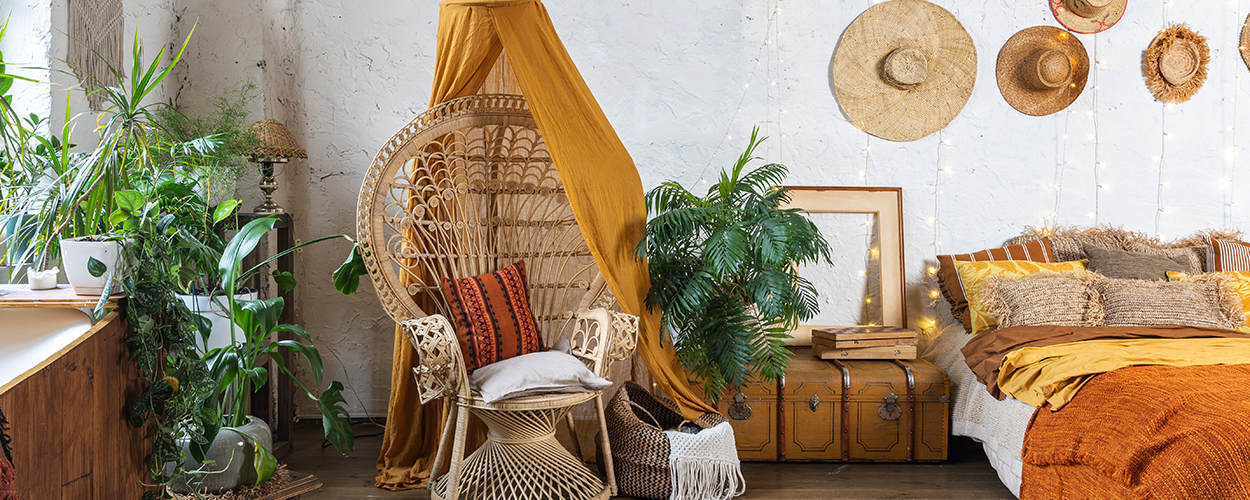
Bohemian Interior Design Characteristics
While there’s plenty of room for creativity when it comes to boho style, there are signature characteristics that distinguish it from other popular counterparts like art deco and mid-century modern. Mix and match your favorite elements to curate a look that is tailored to your preferences.
Colors
There are no strict rules when it comes to color palettes in a boho home. That being said, the bohemian design style tends to incorporate neutral colors like brown, green, white, and gray to create a simple base. From there, you can breathe life into your space with vibrant jewel tones like sapphire, ruby, amethyst, and emerald. Don’t be afraid to be bold!
Materials
As far as materials are concerned, boho interior design leans toward the natural and organic side. Ikat, rattan, sisal, and hand-woven fabrics are a staple you should most definitely include. These materials are diverse in texture and quite uncommon which is exactly why they work so well for this particular style.
Fixture finishes are most often metallic in nature. Gold, silver, brass, and chrome are the most common finishes to choose from.
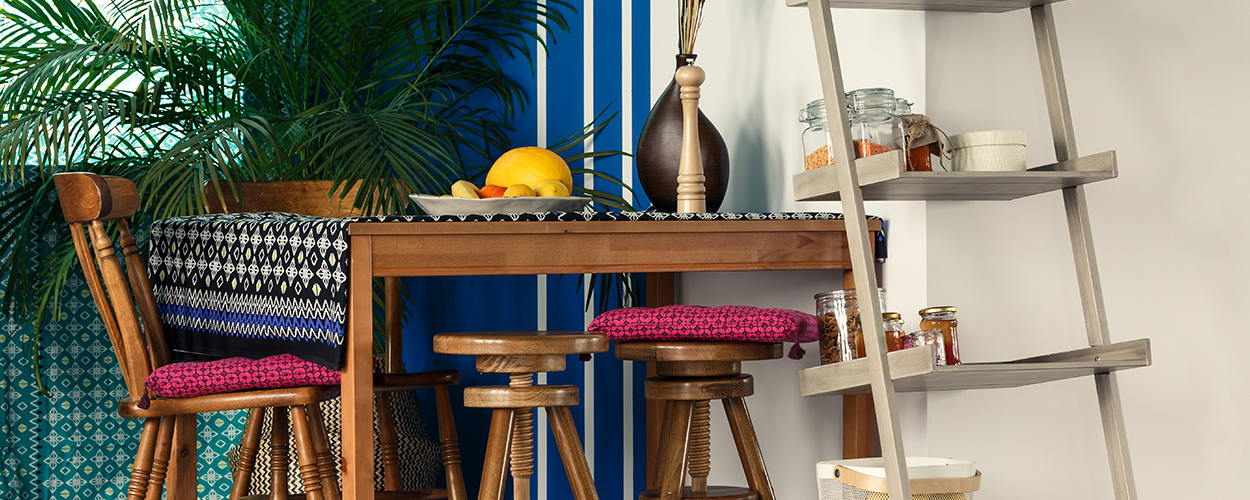
Decor Style
Forget about the pressure of buying the newest, shiniest home decor. One of the beautiful aspects of bohemian design style is the appreciation for all decor—new, old, or distressed. Original or handmade art pieces, flea market finds, or travel souvenirs from around the globe are just what you need for your space.
Bohemian-Style Decorating Ideas
Now that you know a little more about what bohemian design style is and its main characteristics, get a clearer picture of how to put it all together in your living space with these bohemian-style decorating ideas.
Low-Lying Furniture
Bohemian-style furniture is known for being low profile. In the most simple terms, the closer you are to the ground, the better! Low-backed sofas, for example, are a fitting addition to your boho space.
To take this bohemian-style decorating idea to the next level, skip the sofa and turn your attention to the floor. Floor cushions, poufs, rugs, and plush pillows make for authentic boho floor seating.
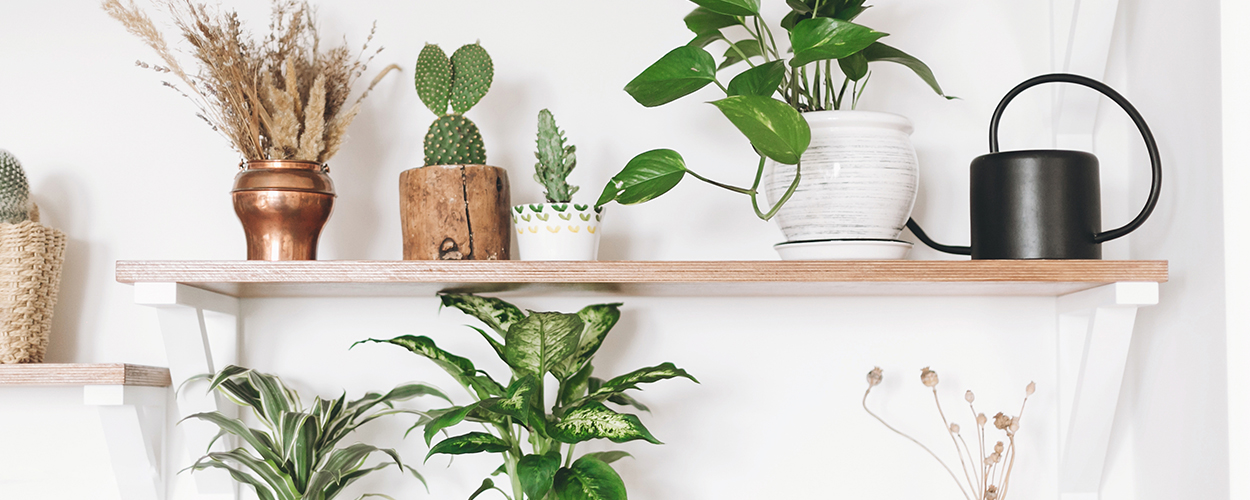
Greenery
Get in tune with the natural world by adding botanicals and other greenery to your home. Natural elements play a vital role in bohemian design, plants in particular.
Not only do they add dimension and color to your living space, they help purify the air as well. All plants are loved in boho design, so go wild with your top picks. Woven hanging plants and botanicals in ornate planters are just the tip of the iceberg. Cacti, succulents, ferns, pampas grass, and calathea plants are a few types of houseplants that work well.
Maximalism
Say goodbye to the “less is more” mantra and hello to maximalism! While empty walls and bare spaces are embraced in other styles, maximalism is an important bohemian-style decorating idea you won’t want to forego.
That being said, maximalism does not mean clutter. Display your most meaningful and loved treasures in a purposeful way where they can be seen and admired. Layer your trinkets, but give them the space they deserve.
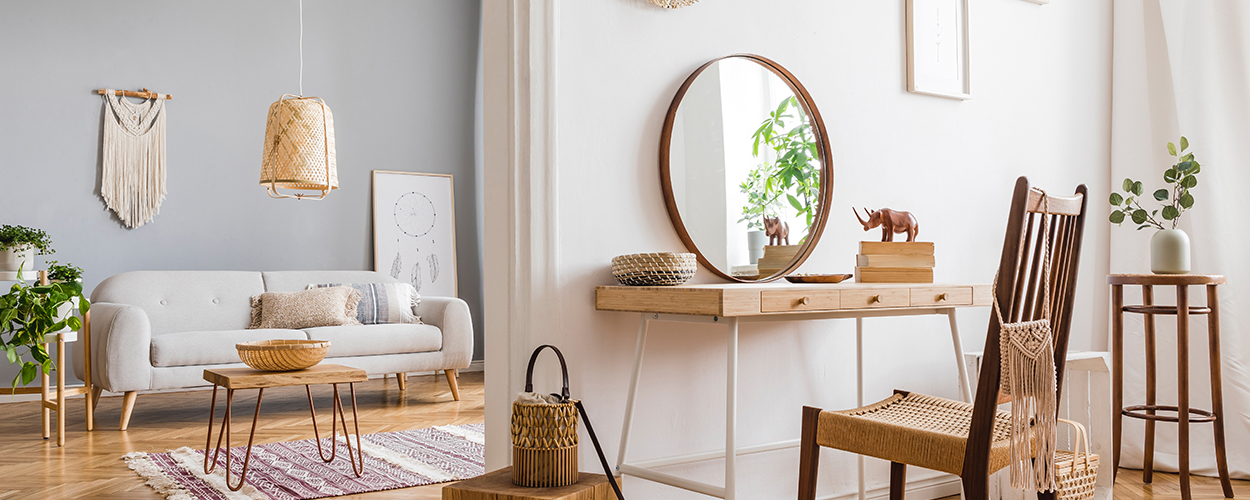
Metallics & Mirrors
Metallics and mirrors both share the podium for signature boho decor. These accessories brighten up your space and give it a touch of subtle glamor without being too extravagant.
A round, gold mirror above your living room sofa and brassy art pieces are a couple easy ways to incorporate this idea into your home.
Distressed Finds
If you’ve decided to try boho interior design, you most likely aren’t too concerned about buying used accessories. That’s an important factor to consider because distressed or second hand items are a special design element of boho style.
You want your items to look like they’ve lived another life when they enter your home—it gives them charm and personality. Whether they come from your own travels, a garage sale, or flea market, choose the most alluring accessories that look like they tell a story.
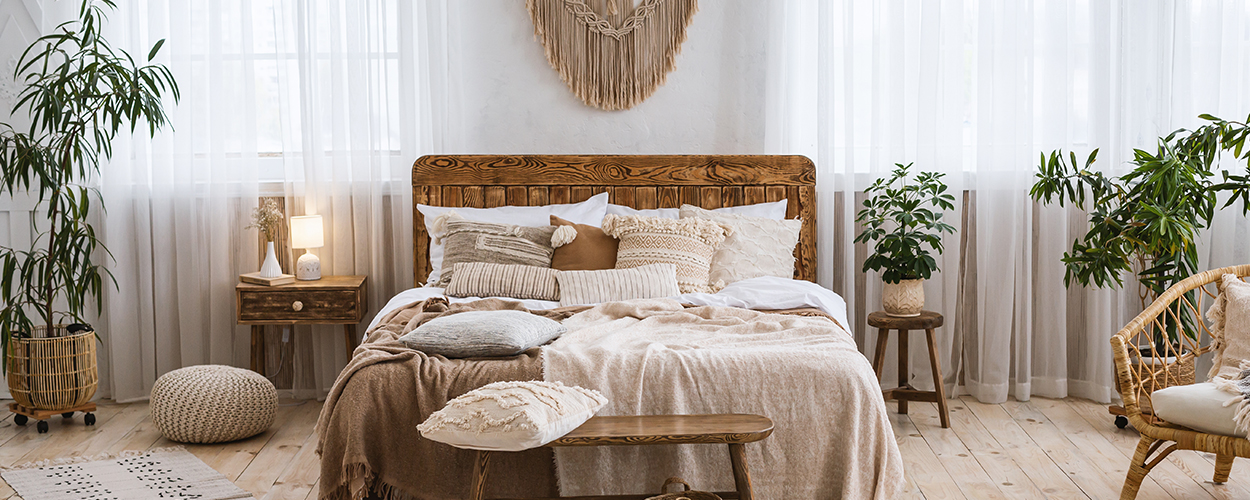
Mixed Patterns
Layered patterns are hands down one of the simplest and affordable ways to master bohemian design style. If you don’t consider yourself an expert interior decorator, stick to these two rules when layering:
- Layer similar patterns
- Follow a consistent color theme
Rugs, blankets, pillows, cushions, and ottomans are a simple way to start layering patterns in your home. As long as you keep the patterns similar and tie together colors, the finished product will look lush and luxurious.
With these bohemian-style decorating ideas and a firm understanding of the meaning behind the name, you are ready to adopt this interior design look inside your home! If you’re interested in learning about more design styles, read about how to turn your space into an art deco dream.
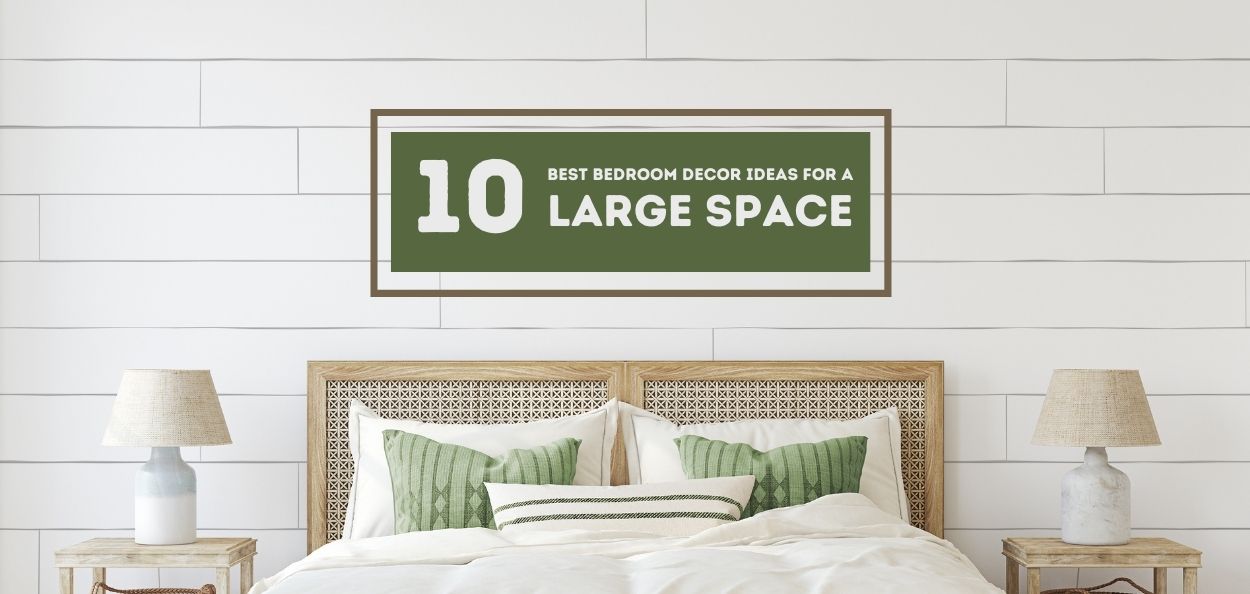
While spacious master bedrooms are a highly sought after luxury, they can be a bit overwhelming to furnish. Besides the traditional bed and nightstand, there are many ways to decorate a large bedroom to make it feel cozy and complete. From accent walls to layered textiles, here are 10 of the best bedroom decor ideas for large spaces.
1. Area Zones
As a beginner just learning how to decorate a large bedroom, this tip is extremely important. Before you go on a shopping spree, it’s helpful to divide your bedroom into area zones to better plan what furnishings you need to buy.
Depending on how massive your space is, you can create multiple zones with different purposes. Place a stylish accent chair in one corner to establish a reading nook, or arrange a small sofa in front of your bedroom fireplace for nighttime relaxation. A vanity area and TV entertainment space are two additional options that fit perfectly in a bedroom setting.
2. Dramatic Drapery
Not sure how to fill up empty wall space? Hang floor-to-ceiling drapery to give texture to your walls. Drapery not only works to insulate your home, it brings a finished look to your space.
When it comes to placement, install your drapes as high as possible to accentuate the height of the room. A good rule of thumb to follow is hang your drapes 8 to 12 inches above the window frame, or about halfway between the window frame and the ceiling.
Additionally, choose the right length of drapes. They should either just touch the floor or hang right above it.
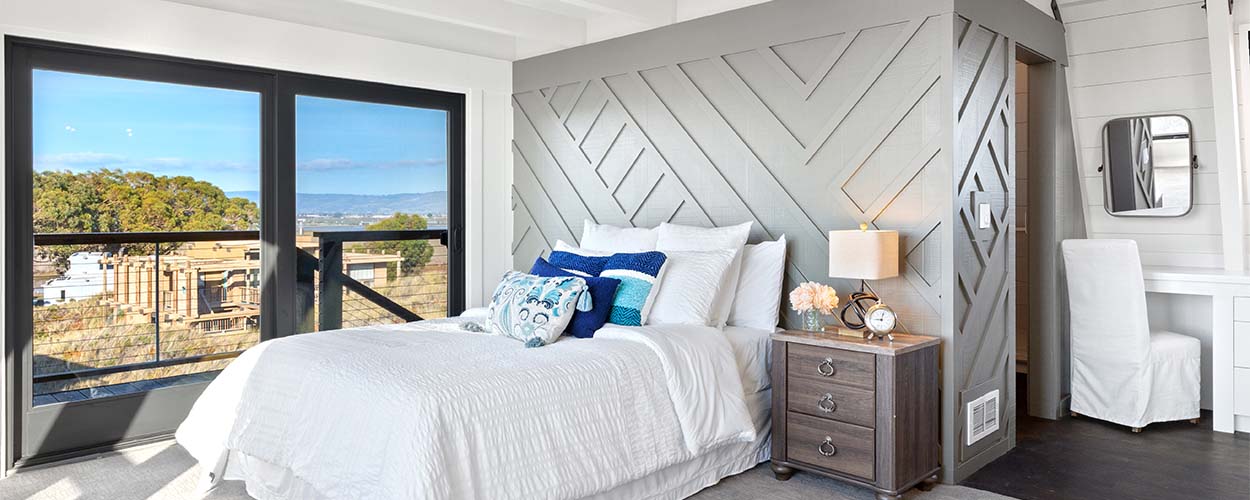
3. Bold Accent Wall
If you’re looking to create a focal point for your space, an accent wall is one of the best bedroom decor ideas to try. Choose a beautiful wallpaper to achieve this look, or simply paint an accent wall with a shade that fits your color scheme. If you’re up for a bigger challenge, you can also consider installing decorative molding or paneling.
No matter which method you decide on, creating an accent wall in your bedroom will give the space more depth and make it feel intimate.
4. Consistent Color Palette
Consistency is key when it comes to interior design. Put together a color palette for your bedroom by choosing a primary color and one or two accent colors. As you decorate your large bedroom, everything from your walls to your throw pillows should fit within your color scheme. This will keep your space well-balanced and avoid any clashing elements.
5. Large Floor Mirror
Not everyone has the space needed for a stunning floor mirror, but they’re worth having if you do. A floor mirror is one of the best bedroom decor ideas because it offers a variety of benefits.
With the correct placement, a mirror can brighten up your space by reflecting sunlight. In addition to that, this bedroom accessory gives your space more character and of course, provides the perfect opportunity to spice up your wall space.
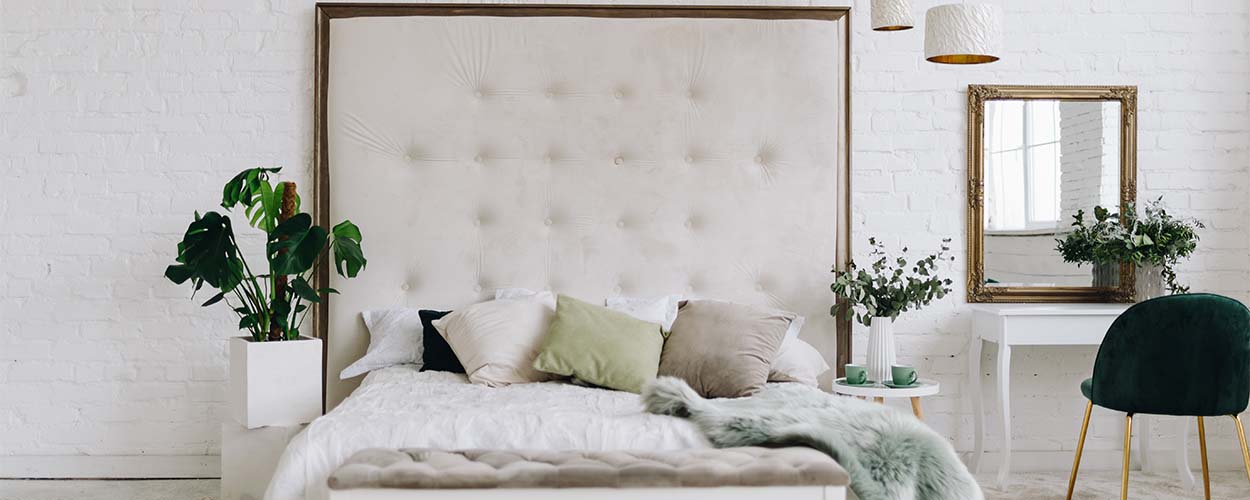
6. Oversized Headboard
As you decorate your large bedroom, add a bold headboard that makes a statement and breaks up the white space. Believe it or not, headboards are a crucial part of your bedroom furniture because they’re an extension of your interior design style. As you pick out your favorite options, think about how they tie into your room’s overall vibe.
7. Lots of Textiles
A foolproof way to transform your spacious bedroom from forlorn to fabulously cozy is throwing in textiles. Blankets, pillows, drapes, and area rugs are the best bedroom decor ideas to infuse within your space. While it’s crucial to stick to your color scheme, professional designers recommend mixing your patterns and textures to create more interest.
8. Scaled Decor
Go big or go home! With a massive bedroom comes the freedom to furnish with big decor. As you think about how to decorate your large bedroom, don’t be afraid to scale up your accessories to appropriately fit the size of the space. The last thing you want is awkwardly small furniture that feels out of place in your room.
Swap out tiny nightstands for chest of drawers, choose a king size bed, or hang a grand chandelier. While bigger is better in this scenario, be cautious of clutter. Be strategic with your decor and know the difference between balanced and busy.
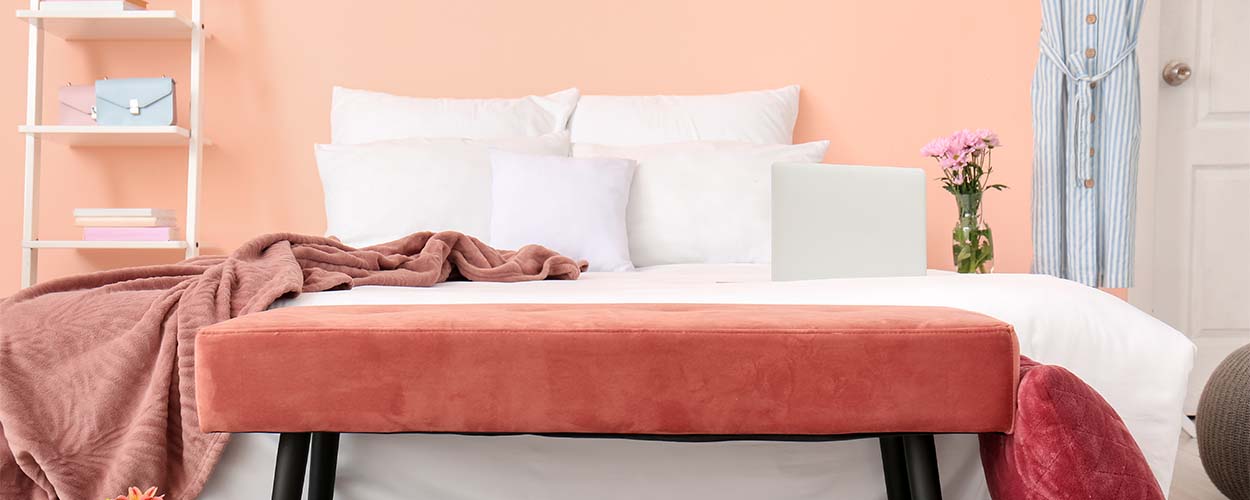
9. Foot-of-the-Bed Decor
This spot can easily be forgotten during the furnishing process, but the foot of your bed is prime real estate when it comes to decorating. Use decorative accessories for purely aesthetic purposes or opt for multifunctional furniture.
Think about how much room you have to work with and consider these creative decor ideas:
- Small sofa
- Baskets
- Chairs
- Dresser
- Trunk
- Desk
- Bench
10. Ceiling Accessories
Whether it’s a fan or chandelier, incorporating ceiling fixtures in your bedroom can completely transform the space. Ceiling accessories break up the room visually, which helps to create more dimension and depth.
Lighting, in particular, is a great idea when it comes to ceiling accessories. Light fixtures ground the room and give it the warmth it needs, especially when it comes to large bedrooms.
Now that you know a little bit more about how to decorate a large bedroom, gather inspiration from the professionals themselves. Check out the 10 coolest home decor influencers to follow on Instagram!
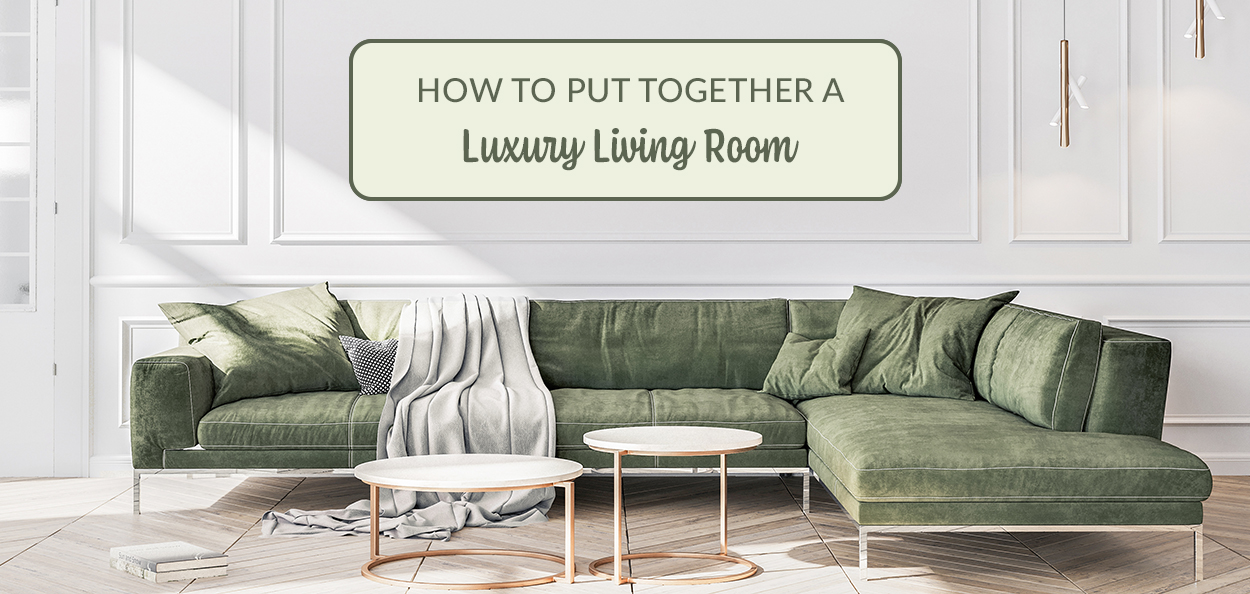
Spending more time indoors has forced Americans to re-evaluate the design and functionality of their homes. Indeed, lockdowns have spurred a home renovation trend. Homeowners spent, on average, $15,000 on minor and major home improvement projects in 2020, which was a 15 percent increase compared to previous years.
With this renewed appreciation for our homes, what better place to start than the living room. As a shared space, it is the room used to host guests or to simply relax as a family. The living room is a popular renovation, as people like to indulge and show off their personality through their choice of interior. If you’re considering making some luxurious changes to your living room, consider these helpful home improvement project tips.
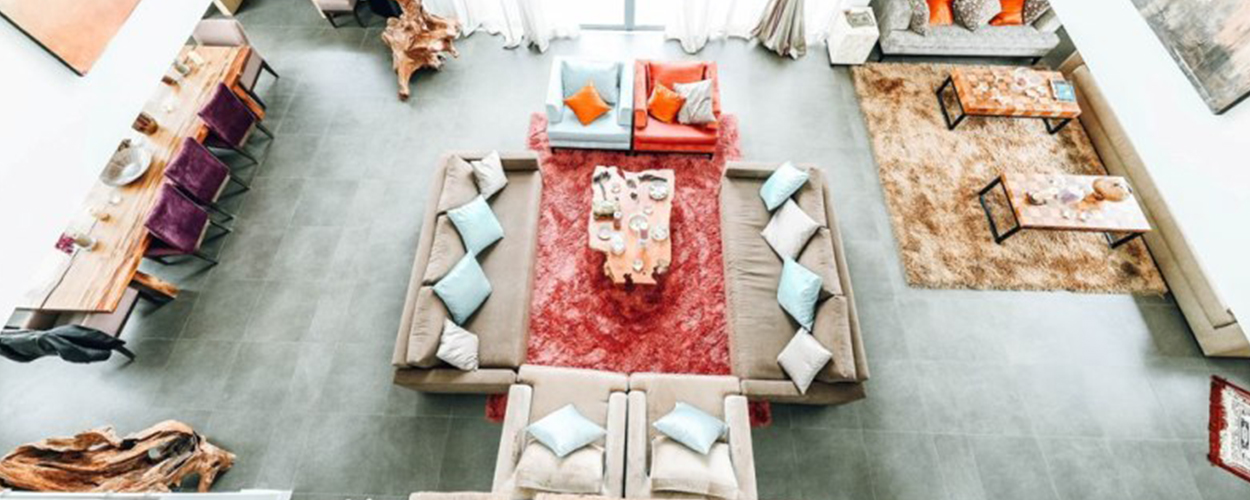
Create a Budget
Before jumping into your makeover, you need to define what you consider a luxury living room idea. This will help you determine the scope of your project, the timeline, and, more importantly, the budget.
Not all customizations for luxury living rooms will break the bank, especially if you’re only adding cosmetic changes, such as high-end furniture or new window treatments. The price of home renovations averages around $10-$150 dollars per square foot. A luxury living room would probably require a budget around the upper end of that range.
According to homeowner surveys, 78 percent of people tend to miscalculate remodel costs due to unexpected mishaps or added shipping fees and taxes, so it’s crucial to include an additional 20 percent of your overall costs as a precaution.
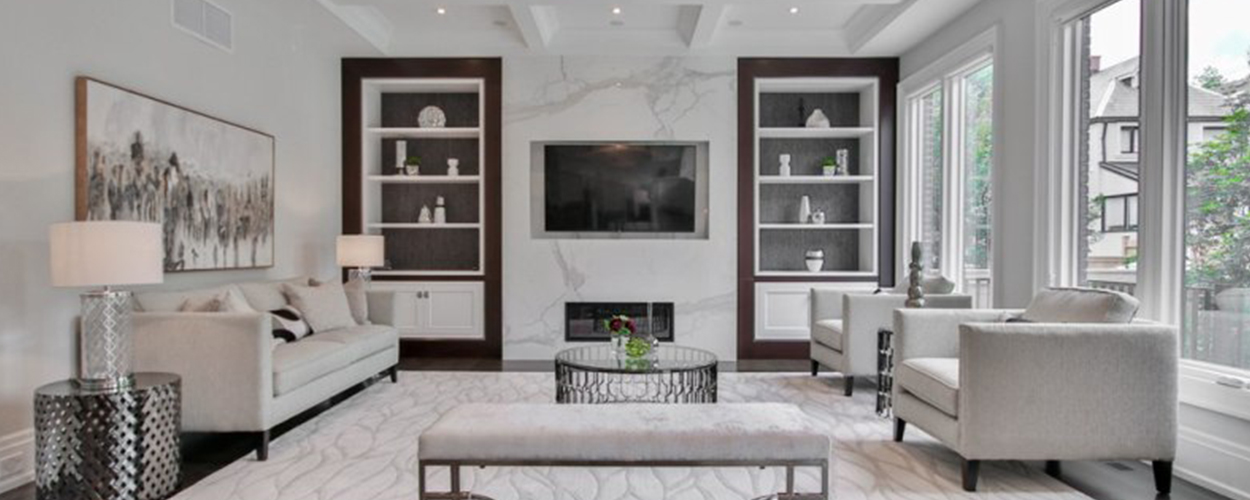
Start Out Simple
Rearranging your furniture is one of the simplest things you can do to change up your living room’s design. An important factor to consider when deciding on an appropriate seating arrangement is the focal point of the area. Orient your furniture towards any standout feature, such as a fireplace or a large window. If there doesn’t seem to be any focal point, you can add accents like art prints or a tapestry.
You can also change your room’s color palette by replacing decor such as rugs, cushions, vases, and throws. Soothing color combinations like forest green and earth tones never go out of style, and saturated, juicy colors like corals and creams are in trend this year.
Another easy living room design tip to try is adding greenery. Decorating with houseplants helps breathe new life into your space and transform it from dull to refreshing.
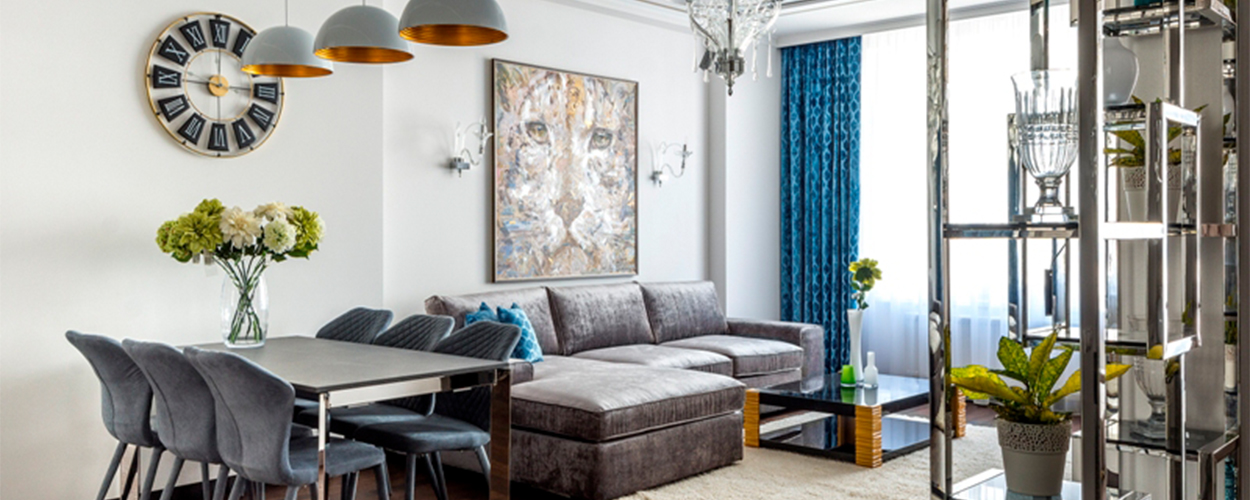
Working Your Way Up
If you’re willing to shell out more money, you can work your way up by changing your flooring and repainting your walls. Slate flooring works great for the industrial and minimalist styles that are very in vogue now. Wood flooring and tiles are more expensive, but these timeless options are well worth the steeper price.
You could also opt for the rising grandmillennial trend of floral wallpapers that evoke a nostalgic, granny-chic vibe. If you don’t feel like using traditional wallpaper, consider our living room design tip and buy peel-and-stick wallpaper instead. It’s an easy way to make a dramatic change and is a smart option if you like to switch up looks often.
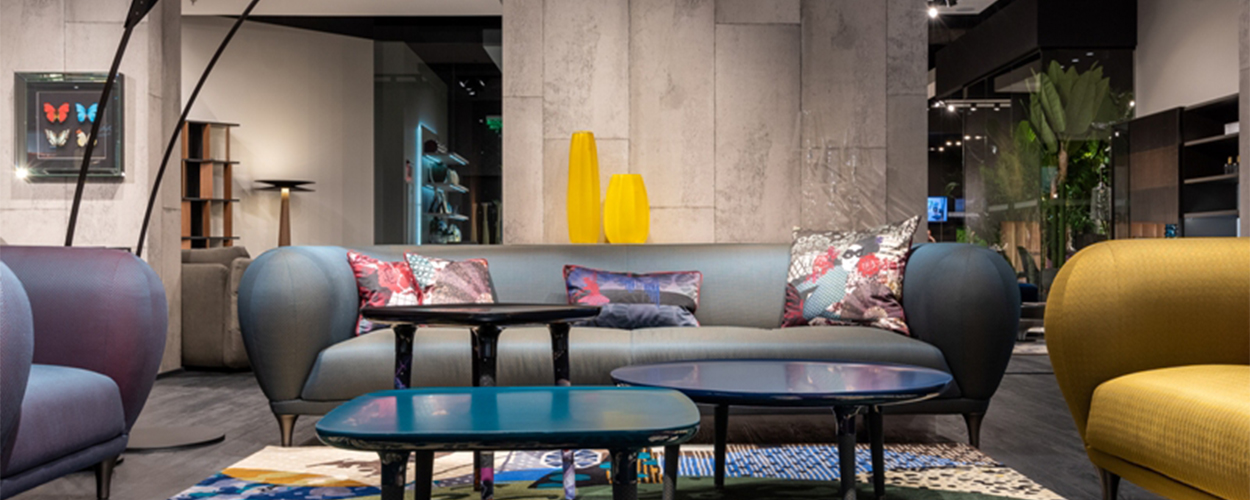
Sitting on the Lap of Luxury
Investing in new furniture can be quite the splurge, but it’s worth the cost if you want a stunning living room. Along with larger furnishings like sofas and sectionals, it’s always a great idea to include an eye-catching accent chair for visual stimulation.
If buying brand new furniture isn’t a possibility with your budget, think about updating one or two of your current pieces by reupholstering..
Lastly, consider upgrading your light source. Artful chandeliers and bold, dynamic lamps have been the rage lately, and are an excellent way to turn a room from drab to fab.
Transforming your living room can be both a daunting and exciting process, but with the help of our living room design tips, your home will come together beautifully. For more inspiration on home improvement projects, check out the 10 coolest ideas for a DIY living room makeover.
Words by Vera Fowler
Written for fusionfurnitureinc.com
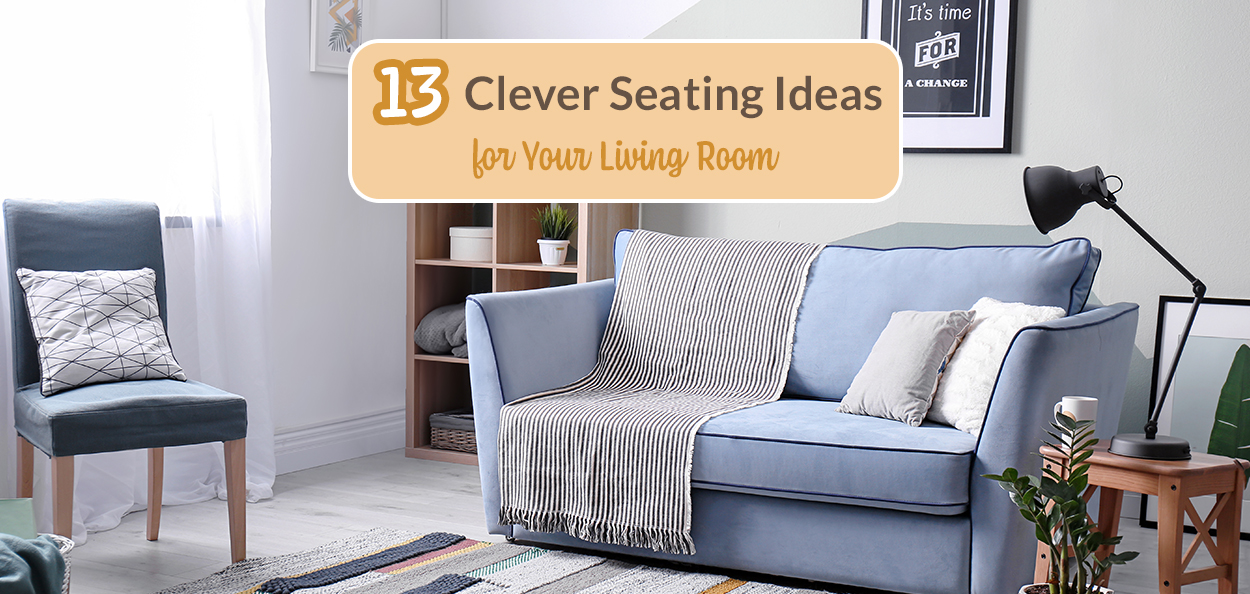
From holiday parties to game nights with family and friends, there’s an endless list of occasions that require lots of seating space for guests. Instead of sticking to just the traditional couch or sectional, maximize your space as much as possible by getting creative with your furniture options. Read on to see the top 13 living room seating ideas that will make your guests happy and comfortable at every social gathering!
1. Opt for Ottomans
While it’s ideal to have a coffee table in your living room, they tend to take up a lot of space that could be used for additional seating. If you can bear to live without a coffee table, opt for an ottoman instead. Ottomans have many more advantages than they do disadvantages. They’re comfortable, trendy, and can function just as well as a coffee table.
If you need a place to put down drinks and food, simply buy an ottoman tray and that’ll do the trick.
2. Give Garden Stools a Try
Garden stools aren’t just for gardening! You can quickly find an indoor garden stool or seat that perfectly matches your interior design style. Set it next to your sofa or accent chair and offer it up as a living room seating idea during your next party!
3. Slide in a Slipper Chair
Slipper chairs are a must if you find yourself entertaining guests quite often. They are ideal for tight spaces because they take up minimal floor space and can be snuck in just about anywhere.
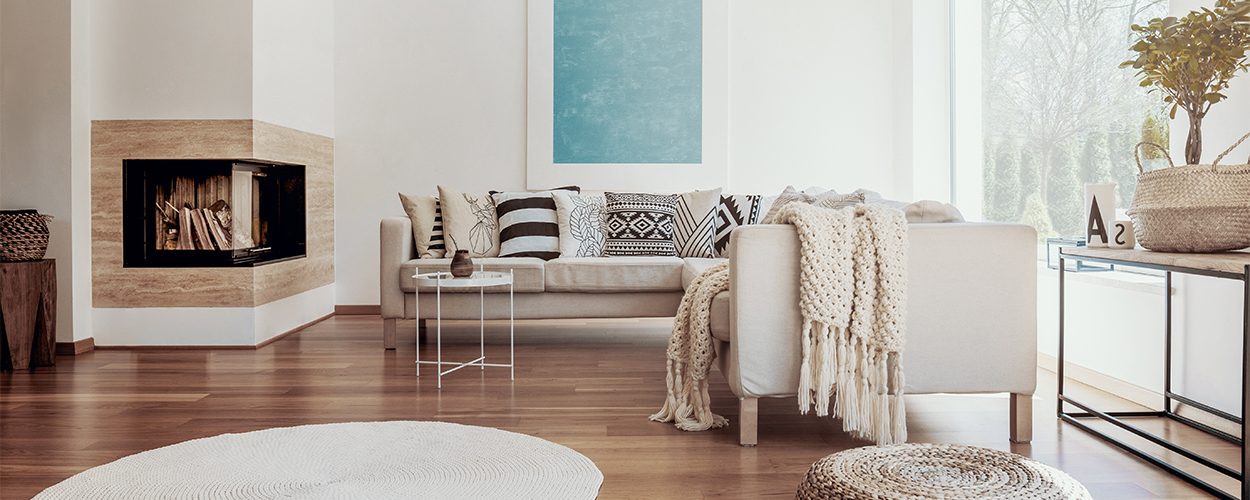
4. Take It to the Floor
Perhaps one of the most underrated furniture pieces is a floor cushion. If you need comfy seating for a small space or even a big one, invest in a couple stylish floor cushions. They’re great for kids and in dire circumstances, will make for a nice seat for adults too.
One of the best parts about floor cushions is that they’re easy to store away in your closet or within your ottoman (if it has storage space).
5. Choose a Multipurpose Coffee Table
If you can’t stand to live without a coffee table in your living room, don’t worry. All you need to do is be a little more strategic when purchasing the perfect table for your needs. Rather than buy one that is solid from top to bottom, opt for a coffee table that allows storage underneath. Use the multipurpose table to tuck away additional seating like benches and floor cushions.
6. Factor in Footstools
Footstools may be small, but they make a huge difference when it comes to entertaining. Use them regularly to prop up your feet and offer them to guests during parties. If you have an open floor plan, you can also utilize footstools to make a distinction between your living space and other areas.
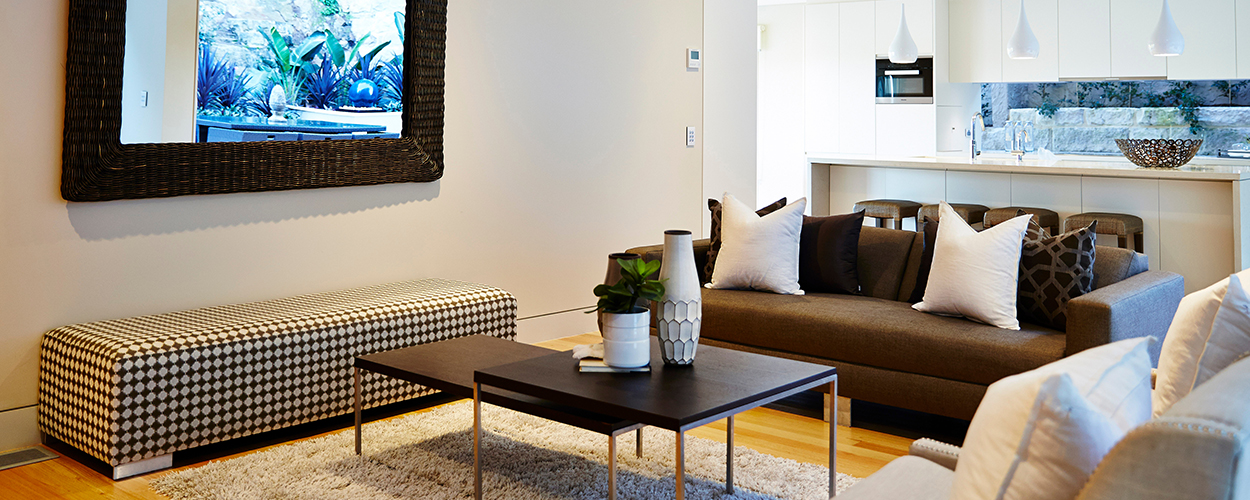
7. Try a Designer Bench
Couches are bulky and dominate a majority of your living room, which is why benches are so sought after. Instead of squeezing two sofas or one large sectional into your space, think about trying a bench. Place it opposite of your sofa, in front of your fireplace, or wherever you see fit.
For those that have an open floor plan, you can also place your bench behind your sofa as a subtle divider and finishing touch.
8. Sneak in Stackable Stools
When in doubt, stack it out! Stackable stools may not be the chicest option, but you’ll be thankful you have them once your living room is crowded with people. Use them as side tables by day and living room seating furniture by night!
9. Bust Out Folding Chairs
You know you’re desperate for seating when you pull out the folding chairs. Are they the most attractive? Maybe not. Are they good to have? Absolutely.
For a fun DIY project, revamp your folding chairs with a little spray paint and stylish fabric. Store them in the garage or under your bed until you need them for social gatherings. Your guests will most definitely thank you!
10. Concentrate on Corners
As you brainstorm living room seating ideas, don’t forget to think about the corners of the room. If you have an empty corner, great! Put it to good use and add in living room seating furniture. If that space is currently occupied by a house plant or lamp, consider moving those items somewhere else so that you can swap in a stool or accent chair.
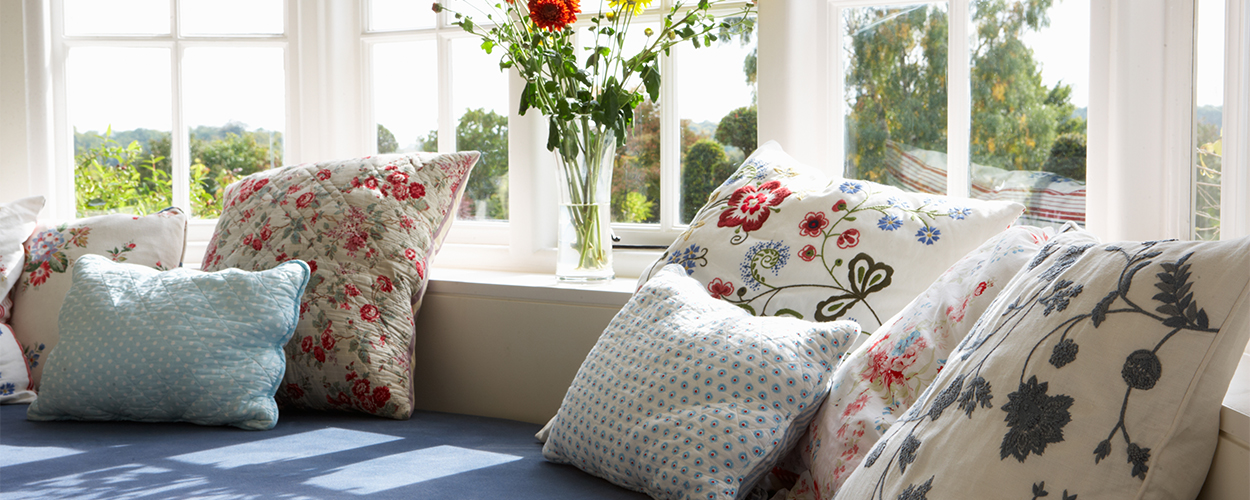
11. Work in a Window Seat
Window seats are a must for any home, but especially if you’re in need of a living room seating idea. Take in the beautiful views from your window by adding a simple bench with cushions and pillows for comfort. Your guests will be fighting for this spot during daytime gatherings!
12. Place Poufs in Empty Areas
Floor poufs are all the rage right now, so might as well try them while they’re hot! Not only are they small and easy to move around, they’re versatile in function. Use them for casual hang outs, play time with the kids, or extra seating during the holidays.
13. Settle for Small Benches
Small benches are the way to go if you’re looking for comfy seating for small spaces. They work well in both casual and formal settings. Mix them into your furniture arrangement for better conversation, set them in front of the TV during game time, or line them in front of your fireplace when it’s not being used.
Having trouble finding enough space to fit all of your living room seating furniture? Learn genius ways to free up space in your living room!

Temperatures are dropping, leaves are turning, and festive fall decor is sweeping the nation! As you celebrate the fall season and all of the holidays that come with it, don’t forget to spice up your letter board for the occasion. From spooky Halloween letter board quotes to Thanksgiving letter board ideas, here are the top 40 sayings you should try this year!
Fall Letter Board Ideas
While it’s fun to get creative and come up with fall letter board ideas on your own, it’s always nice to get a little inspiration. Here are some of the most corny and cute fall letter board sayings that are perfect for the season:
- ‘Tis the season to be fall-y
- Happy Fallidays
- Fall, flannels, football
- Pumpkin spice & everything nice
- Oh my gourd, it’s fall!
- Leaves are falling & coffee is calling
- I love fall most of all
- Sweater weather
- Pumpkin spice, spice baby
- Hello, gourdeous!
- Leaves are falling, autumn is calling
- Pumpkin kisses and harvest wishes
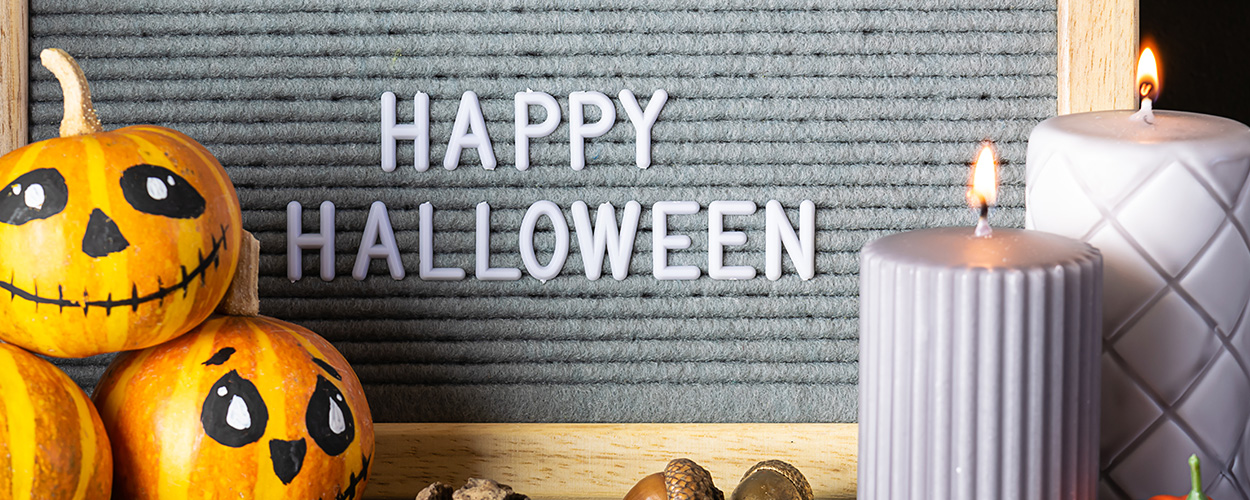
Halloween Letter Board Ideas
Fall isn’t just about pumpkin spice and everything nice! Pay tribute to the spooky season with these Halloween letter board quotes that add a wicked touch to your home decor.
- Trick or treat yo’ self
- Give ‘em pumpkin to talk about
- Creep it real
- Happy howl-oween
- If you got it, haunt it
- Cheers, witches!
- You’ve got me under your spell
- Something wicked this way comes
- It’s just a bunch of hocus pocus
- Hey boo-tiful
- Let’s have some skele-fun!
- Ghouls just want to have fun
- Eat, drink, & be scary
- Spooky!
- Trick or treat
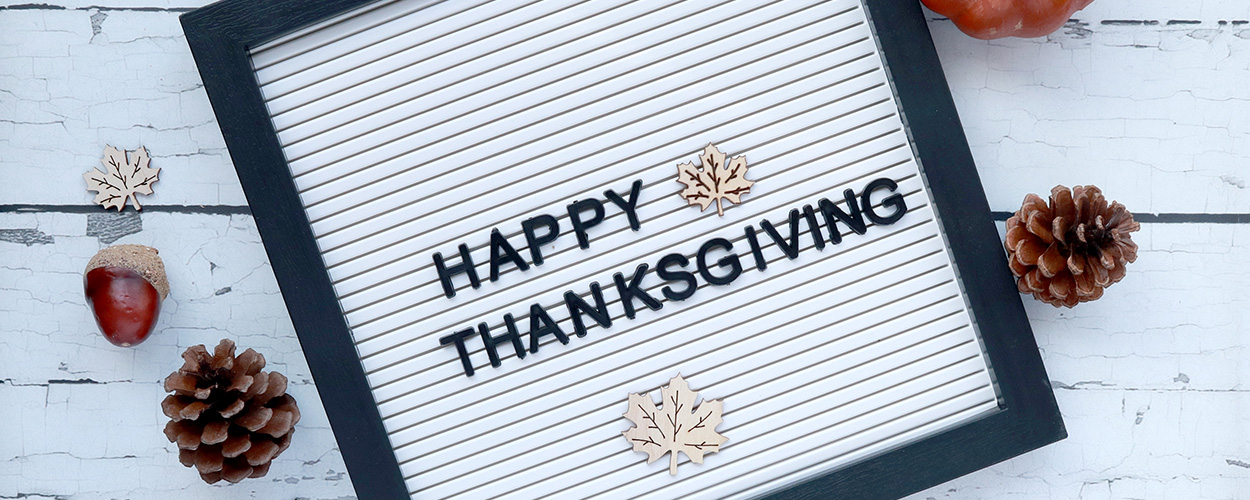
Thanksgiving Letter Board Ideas
In between the party planning and food preparation, remember to try these Thanksgiving letter board ideas that remind you of one of the best parts about the holiday—delicious food!
- Leftovers are for quitters
- Whatever floats your gravy boat
- Thanksgiving rule: no talk, just gobble
- Count your blessings, not your calories
- Thankful for oversized hoodies and leggings
- Thanksgiving: cook, eat, nap
- Alexa, make Thanksgiving dinner
- Sorry, I’m occu-pied
- Give thanks, eat food
- Gobble, gobble
- It doesn’t get any butter than this
- Stop, drop, & pass the rolls!
- Feast mode: activated
Now that you know the top 40 fall letter board ideas, check out these 9 fall decor trends!
